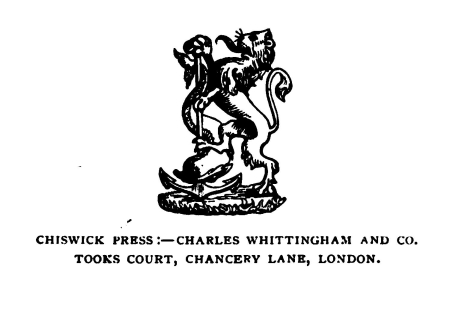PICTURE POSTERS
A Short History Of The Illustrated Placard With Many Reproductions Of The Most Artistic Examples In All Countries
By Charles Hiatt
London: George Bell And Sons New York
MDCCCXCVI
Second Edition

Original

Original
CONTENTS
CHAPTER I. THE STORY OF THE PICTORIAL POSTER
CHAPTER II.—IN FRANCE DURING THE PRESENT CENTURY
CHAPTER III.—IN FRANCE. THE WORK OF CHÉRET, GRASSET, AND TOULOUSE-LAUTREC
CHAPTER IV.—IN FRANCE: THE WORK OF WILLETTE, FORAIN, STEINLEN
CHAPTER V.—IN FRANCE: THE WORK OF GUILLAUME, PALEOLOGUE, CHOU-BRAC
CHAPTER VI.—IN ENGLAND: FROM FRED WALKER TO DUDLEY HARDY
CHAPTER VII.—IN ENGLAND: THE WORK OF DUDLEY HARDY, AUBREY BEARDSLEY
CHAPTER VIII.—THE WORK OF OTHER CONTEMPORARY ENGLISH DESIGNERS
CHAPTER X.—IN COUNTRIES NOT ALREADY DISCUSSED
CHAPTER XI.—THE PRICE OF THE PICTORIAL POSTER; AND CONCLUDING NOTE
PREFACE.
In the present volume an attempt has been made briefly to trace (the history of the picture poster from the earliest times!) and to comment upon and reproduce some of the most noteworthy examples in various countries. The English and American placards have received special attention, while the best examples of the French school have not been overlooked. With very few exceptions, only posters signed, or acknowledged, by the artists producing them, are included among the illustrations. The whole subject is treated from the point of view rather of art than of commerce. While it is believed that this book is the first which deals in English with the Pictorial Poster, the author desires to recognize his indebtedness to M. Maindron's work, and to the catalogues of M. Sagot and Mr. Bella. The last-named has rendered material aid by lending, for the purpose of reproduction, not a few examples contained in his collection.
To name the artists and owners of valuable copyrights who have laid the author under obligations would, however carefully compiled, almost certainly contain serious omissions. It is hoped, therefore, that those whose names would figure in such a list will acquit him of intentional discourtesy or ingratitude. Special thanks are due to Mr. Gleeson White for his editorial work in connexion with this volume; indeed, whatever merits it may possess are due, in no small degree, to his care and assiduity. Although personally unknown to the writer, Mr. Spiel-mann has been so good as to assist materially in the matter of illustration. To the kindness of M. Henri de Toulouse-Lautrec is owing the frontispiece in the shape of a hitherto unpublished study for a poster; while the reproduction of a sketch for the "Phit-Eesi" placard was courteously consented to by Mr. Dudley Hardy, and Messrs. Vaterlow who printed the poster itself. The cover has been specially drawn by Mr. Charles Ffoulkes, to whom the writer desires to express his sincere thanks. The Artistic Supply Company (Limited) have been so good as to consent to the reproduction of unpublished copyright designs by Messrs. Bernard Partridge, Max Cowper, the Brothers Beggarstaff, Sydney Adamscm, Kerr Lawson, A. R. Wilson, and Lewis Baumer. A design, representing Sir Henry Irving as "Don Quixote" is illustrated here owing to the kindness of Miss Ellen Terry, who owns the original.
Charles Hiatt
October, 1895.
PICTURE POSTERS.
CHAPTER I. THE STORY OF THE PICTORIAL POSTER
It would be merely foolish to pretend that the pictorial poster, looked at from the point of view of art, is of the same importance as a portrait by Velasquez or an etching by Rembrandt. Its aesthetic qualities have of necessity to be subordinated to its commercial qualities; the artist is the servant of the tradesman. His first business is not to achieve a decoration, but to call the attention of the man in the street to the merits of an article. He may be fantastic only in so far as his fantasy assists the advertisement; he must ever keep before his eyes the narrow object of his effort. The closest limits are set to his invention; it is not for him to do what he will, but rather to do what he must. Under such circumstances, it is, at the first blush, somewhat surprising that artists have condescended to the poster at all. The bounds of freedom in the cases of painting and of sculpture are, comparatively speaking, so wide that one is not unnaturally amazed that the artist of talent is willing to work within the strict limitations imposed on him in the production of a pictorial poster. And yet, after all, to the ingenious designer there is a certain fascination in the very strictness of these limits; the complexity of the problem allures him, and gives him the appetite for experiment. Moreover, if he believe that art is something more than a vague grace, a non-essential luxury, he is ever anxious to extend her domain, to make her empire universal. He believes it to be his mission to touch some ugly necessity, to inform it with art, and, in doing so, to adorn it. He is restless for new worlds to conquer, for fresh fields to occupy. His ideal is art everywhere, art in all. He would fain give style and grace even to the paraphernalia of commerce: the necessities of trade shall not be hideous if he can make them otherwise. And so it happens that he is willing, nay eager, to turn his attention to the poster, with the result that the hoarding becomes an interesting, even a charming, gallery of designs. What was one of the most hideous of human inventions is transformed into a delight to the eyes. Colour and interest are added to the street; the gay and joyous take the place of the dull and ugly.
It follows, supposing that I have stated the case fairly, that it is not derogatory to the dignity, even of a very great artist, to apply his talent to the poster.
It is clear that the poster is one of the oldest and most obvious forms of advertisement. It is almost impossible to conceive a time in the history of man, once he had learned to express his thoughts in design or in writing, when the idea of the thing did not exist. It must have been an incident of the most crude and ancient of civilizations; even the cave-dweller in the dim and distant past must surely have possessed the essential idea of it. From the cave-dweller to the comparatively complex civilization of the ancient and greater Egypt is a far cry. That the mural inscription, which is obviously the germ of the poster, flourished exceedingly in the Land of the Pharaohs is matter of history. A papyrus is comprised in the collections of the Louvre, which may fairly be described as a poster. It is dated so early as 146 b.c., and deals at length with the escape of two slaves from the city of Alexandria, offering a reward to anybody who should discover their place of retreat. Still more interesting, though less ancient, is an inscription in Greek, discovered in the Temple at Jerusalem, in 1872, by M. Clermont-Gannerau. It was issued during the reign of Herod the Great, and forbids the entry, by foreigners, to certain parts of the Temple on pain of death.
Of the poster in Greece we know very little. Legal inscriptions were undoubtedly written on whitened walls, or on axones, the latter being wooden tablets painted white, and made to revolve slowly on an upright axis. In passing from Greece to Rome, we pass from somewhat fragmentary to comparatively exact: information. The Roman notice-board was called an album, and it is a matter of dispute whether it was white with black letters, or of a dark colour with the text in white. Anybody who took away, destroyed, or mutilated an album was liable to an actio albi corrupti, and to heavy damages besides. It appears to have been invented in the first place, in order to give publicity to the annual edict of the Prætor; subsequently, however, the word album was used to signify any tablet on which a public announcement was inscribed. The ruins of Pompeii have furnished us with at least one interesting fragment of an album, on which are written notices of the most diverse kinds. Amongst them are the following:
FAMILIA. GLADIATORIA VENATIO. ET. VELA.
and:
A. SVETTII. CERII.
AEDILIS. FAMILIA. GLADIATORIA. PUGNAVIT. POMPEIS. PR. K. IVNIAS.
VENATIO. ET. VELA. ERUNT.
and again:
DEDICATIONS THERMARUM. MUNERIS.
ENAI. ALLEI. NIGIDII.
MAII. VENALIO. ATHELA.
SPARSIONES. VELA.
ERUNT. MAIO. PRINCIPI.
COLON IÆ. FELICITER.
As for the Roman bookseller, he was in the habit of placarding his shop with the titles of books just published, or about to be published. Take, for instance, the shop described by Martial in the lines:
" Contra Caesaris est forum taberna,
Scriptis postibus hinc et inde totis,
Omnes ut cito perlegas poetas.
Illinc me pete.
The actor has never been inclined to hide his light under a bushel. Advertisement has always been dear to him, and it is not surprising to find that the Roman actor made the most of the opportunity of the publicity offered to him by the album. Not content with having his name inscribed in gigantic letters, he went a step further, and anticipated the illustrated affiche. Just as Sarah Bernhardt employs the decorative skill of Grasset to depict her as Joan of Arc, so did the old Roman actor employ Callades, an artist mentioned very favourably by Pliny, to portray him in his favourite parts. Callades would seem to have been the Chéret of his age: he was the great artistic advertiser of ancient Rome, just as Chéret is the great artistic advertiser of modern Paris.
It is obvious, then, that the idea of the illustrated poster existed among the Romans: the difference between Callades and Chéret is one of method rather than of vital principle. And even the difference in method is slight.
Of the poster in the time which immediately succeeded the fall of the Roman Empire we have very little trustworthy information. It is possible that the Romans introduced the album into Gaul and into Britain, and that the sight of it became as familiar to the inhabitants of Eboracum and Uriconium as it was to the natives of Rome and Pompeii. A French historian of distinction has stated that the affiche was employed by the earliest of the kings of France, but this statement can hardly be said to be borne out by facts. It is at least certain that the signboard, which is a variation of the pictorial poster, was employed in the early part of the Middle Ages. The poster, unless illustrated, would have been useless in a community in which the art of writing was held effeminate, in which the most illustrious knight openly boasted of his inability to sign his name. The principal means of advertisement at that time was the public crier. As early as the twelfth century the criers of France formed an organized body, "for," as Mr. Sampson tells us in his History of Advertising, "by a charter of Louis VII. granted in the year 1141 to the inhabitants of the province of Berry, the old custom of the country was confirmed, according to which there were to be only twelve criers, five of whom should go about the taverns crying with their usual cry, and carrying with them samples of the wine they cried in order that people might taste. For the first time they blew the horn they were entitled to a penny, and the same for every time after, according to custom.... These wine-criers are mentioned by John de Garlando, a Norman writer, who was probably contemporary with William the Conqueror." The wine-crier is frequently mentioned in early French street-ballads. To instance one of them:
"Si crie l'on en plusors leurs
Si bon vui fort a trente deux
A seize, a douze, a six, a huiet."
In England also the crier was an early institution, for we find one Edmund le Criour mentioned in a document dated 1299. Even when the crier was the pre-eminent advertiser, the poster, or at least the handbill, had its place. At first the bills were written, but almost as soon as Caxton introduced the newly-discovered art of printing they were produced by that method. Perhaps the earliest English poster is that by which Caxton, about the year 1480, announced the "Pyes of Salisbury Use," at the Red Pole in the Almonry at Westminster. The size of this broadside is five inches by seven, and the text runs as follows:
"If it please any man spirituel or temporel to bye our pyes of two or thre comemo-racio's of Salisburi use, emprunted after the form of this prese't lettre, which ben wel and truly correct, late hym come to West-monster, into the almonestrye at the reed pole ane he shall have them good and chepe.
"Supplico stet cedula."
The "pyes" in question, it may be noted, were a series of diocesan rules.
It is in the sixteenth century that we meet with the poster properly so called. For example, we have a royal proclamation of François I relating to the police of the city of Paris, which runs: "Nous voulons que ces présentes ordonnances soient publiées tous les moys de l'an, par tous les quarrefours de cette ville de Paris et faux bourgs d'icelle, à son de trompe et cry public. Et néantmoins quelles soient attachées a un tableau, escriptes en parche-main et en grosse lettre, en tous les seize quartiers de ladite ville de Paris es esdiétz faux bourgs, et lieux les plus éminents et apparens d'iceulx, afin qu'elles soient cognues et entendues parfun chacun. Et qu'il ne soit loysible oster les dictz tableaux, sur peine de punition corporelle, dont les dictz commissaires auront la charge chacun en son quartier."
The words "attachées a un tableau, escriptes en parchemain et en grosse lettre" leave no doubt that the poster as we now know it was a usual method of advertisement in the reign of François Ier. The affiche soon after received the attention of the French legislature, for the production and exhibition of posters of certain kinds in France, was expressly forbidden by "un arrêt du Parlement" dated the 7th of February, 1652. To publishers and booksellers, however, the privilege of posting the titles of their new books was specially reserved.
As printing became less expensive and methods for the mechanical reproduction of pictures and designs were discovered, it needed no great ingenuity to add emphasis to the poster by means of pictorial illustration. Acrobats, the stall-keepers at fairs on the ice, and the like, were speedily induced to adorn their advertisements with rude drawings, while Royal proclamations were usually decorated heraldically. Early in the eighteenth century, the bills announcing the departure and arrival of coaches were headed by pictures, as for example the one which related to the Birmingham coach in 1731.
Even earlier in date, there are illustrated advertisements relating to the Roman Catholic church. One of these, produced in France, dated 1602, is very curious and elaborate in design. While, however, many posters such as this are profoundly interesting to the archaeologist, they can hardly be considered works of art. It is not until the middle of the present century is reached that we find important examples of pictorial poster deliberately planned by an artist. The modern artistic poster movement, as we shall see in the next chapter, had its origin in Paris some fifty years ago.
CHAPTER II.—IN FRANCE DURING THE PRESENT CENTURY
As we have seen, the idea of the poster, and even of the pictorial poster, is an extremely ancient one, but it is only at the commencement of the present century that distinguished designers deliberately attempted to make the pictorial poster a work of art. The few posters, at once pictorial and artistic, which are of earlier date than the time in question, are artistic by accident rather than by deliberate intention. So early, however, as the year 1836, we find a really distinguished French artist, Lalance, producing a poster. Lalance was, perhaps, the pioneer of pioneers, and his advertisement for the book, "Comment Meurent Les Femmes," if not of great artistic interest, cannot be overlooked in any book dealing with the history of art as applied to the poster. Only a fewr copies exist. Immediately succeeding him, we have Célestin Nanteuil engaged in producing an advertisement for an edition of "Robert Macaire," dated 1837. The year following, Rafifet brought out his "Napoléon de Norvins." This work is signed as well as dated. Raffet, in addition to the "Napoléon de Norvins," designed two more posters dealing with the career of the great emperor as well as the history of Algeria. Very soon after comes an important affiche, "Le Prado," by Eugène Gauché, and from that time the artistic poster became an established institution.
It may be fairly stated that the direct cause of the artistic poster in France was the illustrated book. The illustrated book, issued in weekly or monthly numbers, has always appealed keenly to the French, and it is usual to give the first number for nothing to all who care to ask for it. The illustrators of these books were very frequently induced by the publishers of them to do a poster advertising the edition of the works they had illustrated. Sometimes one of the illustrations in the book was merely enlarged and lithographed, but more generally the artist made a special design. Perhaps, at the time, the most widely known among French producers of the affiche illustré was Gavarni. The vogue for the works of this eminent illustrator and satirist is perhaps not so great as it was twenty years ago. At all events, the value of his works is not nearly so great as it was then, and it has become usual to talk of him in a manner which is patronizing rather than genuinely appreciative. It may be that his

Original
savage and grotesque point of view discounts his merits as an artist. His power and originality, however, few will deny.
Among the posters which he designed, one of the most characteristic is the "Oeuvres Choisis." The original is extremely rare,

Original
but a copy exists in a folio volume in the British Museum, in which one or two other posters by Gavarni will be found. For the "Almanach Imperial, 1846," by

Original
E. Marco de S. Hilaire, illustrated by Bertrand, a poster (which was, perhaps, an enlargement of the cover) exists. It is a very

Original
OUVRAGE COMPLET, a jingo affair, representing the French emperor standing on the globe with the imperial eagle of France at his feet. Of a little later date are several interesting posters by Grandville. Amongst them are "Les Metamorphoses du Jour" (of which a number

Original
of pigs in different costumes is the main feature), "Des Animaux," "Ma Tante," "Petit Misère," and "St. Helène." Of the two latter I need say nothing, since they are reproduced here, save that they are included in the collection of the British Museum. An illustrated poster very characteristic of

Original
its period, insomuch as it is intensely grotesque, is the "Voyage ou il vous plaira," by Tony Johannot. Its central figures are a monstrous dwarf holding a lantern, a crouching dragon, and an immense notice-board. An affiche which is, perhaps, of

Original
even more general interest, is one done for an illustrated edition of "Don Quichotte," in which the very perfect, gentle knight is represented with a grotesqueness which would certainly have astonished Cervantes himself. Of a similar kind is the "Nains Célèbres," by E. de Beaumont. An illustrated poster of a kind utterly different to the one last discussed is by T. H. Frère. It was designed for the advertisement of a work entitled "La Touraine," by Stanislas Bellanger de Tours. Under no circumstances should one overlook an affiche of about the same period on account of the great personality of its designer. It is very generally admitted that the name of Edouard Manet is one of the greatest in the history of modern painting. It would indeed be difficult to over-estimate the extent of his influence on the pictorial art of the day. The poster reproduced in these pages is not unworthy his great talent. It is curious to notice that Manet and Fred. Walker, an English artist of about the same time, as to whose genius all are agreed, should have been at one in their endeavour to make the illustrated poster artistic as well as merely pictorial.
I have not attempted to deal with any save the most prominent of the great number of French designers who took part in the poster movement during the fifties. Their names and the titles of some of their works will be found in the first catalogue of M. Ed. Sagot, and valuable criticism is contained in the pages of M. Maindron.
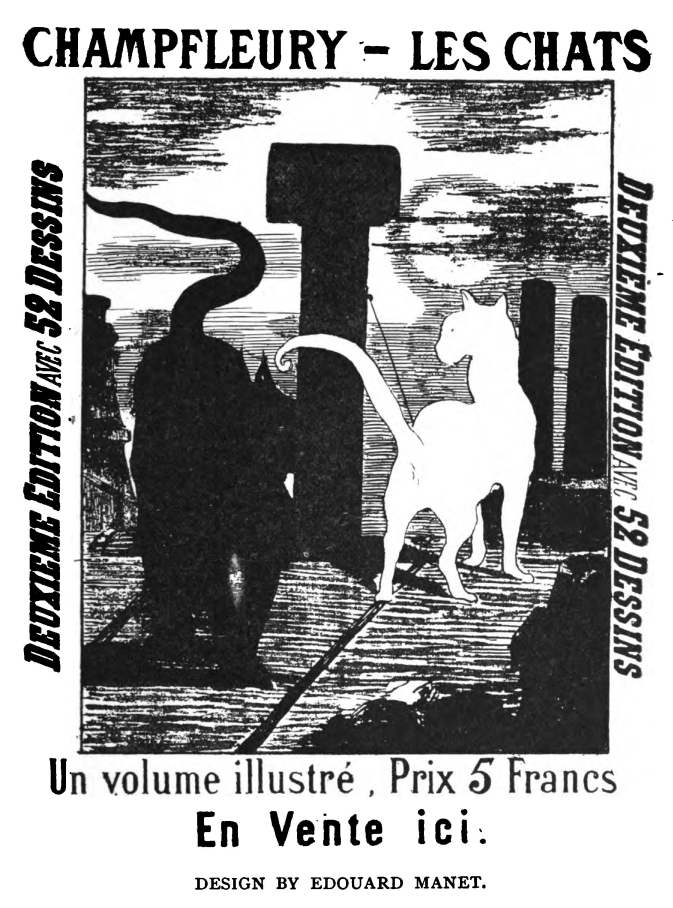
Original
CHAPTER III.—IN FRANCE. THE WORK OF CHÉRET, GRASSET, AND TOULOUSE-LAUTREC
So many contemporary French artists are designing posters, that a single chapter dealing with them all would be of an alarming length. I have therefore, in the first place, separated from their fellows three who seem to me curiously individual and worthy of careful consideration. Of the men whose names head this chapter, pre-eminence is due, for various reasons, to Jules Chéret, whose position, in the matter of poster-designing, is quite without parallel.
It may be that men of rarer, of more fascinating, talent have now and again devoted themselves to the affiche; but none of them can compare with Chéret in the magnitude and curiosity of his achievement. Many have produced charming wall pictures: nobody, save Chéret, has made an emphatic mark on the aspect of a metropolis. Paris, without its Chérets, would be Paris without one of its most pronounced characteristics; Paris, moreover, with its gaiety of aspect materially diminished. The great masses of variegated colour formed by Chéret's posters greet one joyously as one passes every hoarding, smile at one from the walls of every café, arrest one before the windows of every kiosque. The merits of the Saxoléine lamp, the gaieties of the Moulin Rouge, the charms of Loie Fuller, the value of a particular brand of cough-lozenges, are insisted upon with a good-humoured vehemence of which Jules Chéret alone appears to know the secret. Others, in isolated cases, have possibly achieved more compelling decorations, but none can pretend to a success so uniform and so unequivocal. Few men as richly endowed with the gift of decoration would! have been content to produce work which, were it not for the portfolio of the collector, would be of an entirely ephemeral character. It must be irritating to the artist to watch the gradual destruction of his chefs-d'oeuvre, condemned as they are to be torn by every wind, soaked by every shower, blistered by the sun, blurred by the fog. It is natural that he should turn his eyes longingly to the comparative permanence of canvas, marble, or bronze; and it says much for Chéret's confidence in his artistic mission for his nice realization of his possibilities and limitations that he has remained faithful to the affiche for over twenty years. Now and

Original

Original
again, it is true, he has turned aside to do work of more universally recognized and more pretentious a character, and the very fact that he has touched scarcely anything which he has not adorned, emphasises his fidelity to a branch of art until quite recently despised and held of little moment. It is, indeed, mainly owing to this devotion, to this lavish expense of talent, that the poster is not even now considered beneath the dignity of the collector. The judicious, as soon as their eyes fell upon Chéret's vast lithographs, decided that he was no mere colour-printer's hack, but an artist whose work would have to be reckoned with. There was something positively alluring in the spectacle of a man who calmly placed his gift at the disposal of the tradesman, who accepted without murmur the limitations which the tradesman imposed upon him. It is possible that, had it not been for the circumstances of his life, the streets of Paris would have remained undecorated, so far as Chéret was concerned, to this day. Commencing as the humblest of lithographers, Chéret did not take up art of set intention, but passed irresistibly, though it may be unconsciously, into it. After long years of patient and tedious work as an ordinary lithographer, at the dawn of the year 1866, he commenced what was destined to be the most notable series of pictorial posters in existence, a series containing over a thousand items, and one which happily has yet to close. It is doubtless the conditions of his early life, the lessons learned while under the yoke of trade, that have enabled Chéret to appreciate to the full that the first business of an advertisement is to advertise. Avoiding, therefore, all subtle harmonies, he goes in for contrasts of colour, violent, it is true, but victorious in their very violence. Blazing reds, hard blues, glowing yellows, uncompromising greens, are flung together, apparently haphazard, but in reality after the nicest calculation, with the result that the great pictures, when on the hoardings, insist positively on recognition. One might as well attempt to ignore a fall of golden rain, as to avoid stopping to look at them; they are so many riots of colour, triumphant in their certainty of fascinating and bewildering the passerby.
As may be imagined, Chéret's skill has fullest scope when dealing with the lightest and gayest subjects: a cascade de clowns—to borrow a phrase of Huysman—an entrance of ballet girls; a joyous troupe of children, contented because toy-laden; these, and the like, are subjects most congenial to him. His style is essentially the outcome of the day. It possesses no decorative forerunners; it is not a thing derived; its parents are the gaieties of modern Paris. It is intensely actual, and in its actuality lies, it

Original
seems to me, its greatest claim to consideration. It is infused with a somewhat hectic gaiety which holds a not unimportant place in the lives of us suffering from this "sick disease of modern life." Of the sick disease itself, Chéret gives no hint. He is unflagging in his vivacity, unswerving in his insistence on the joie de vivre; instead of pondering over the inevitable sorrow of life, he busies himself depicting the naïve grace of the child, the elegance of the mondaine. His gifts lead him inevitably to such subjects. His merit as a draughtsman lies, in part, in vivacious rather than correct line: gaiety, as we have seen, is the chief quality of his colour: his composition is remarkable on account of the piquancy and appropriateness of its detail. He chooses with unerring fidelity the subjects suited to his temperament and his gifts. These subjects are not of infinite variety, and it follows that if one sees a great quantity of Chéret's work together, one becomes aware of a certain feeling of monotony. One can be satiated even of Chéret's gaiety and joyousness.
To attempt any account of Chéret's thousand and more posters, is obviously impossible in any but an elaborate monograph devoted exclusively to him. I can do no more here than comment on a few of the most striking. It may be stated generally, that while the earlier ones are rarest because most difficult to procure, the more recent designs show the artist at his best. A mastery of chromo-lithography such as his, cannot be obtained without many essays, some of which are foredoomed to failure. In addition, Chéret has gradually improved alike in the splendour of his colour, and the disposal of his pattern. Perhaps he has never been happier in his treatment of children than in one or two of the "Buttes-Chaumont" series. The joy of the little ones in the possession of their new playthings is contagious. Utterly different in kind, though not less conspicuously successful, is "Les Coulisses de l'Opéra au Musée Grevin," a delightfully piquant representation of a group of premières danseuses in the traditional costume. As a specimen of amazingly effective and strangely beautiful colour, it would be difficult to exceed the "Loie Fuller" series; while, in the matter of pert gracefulness, Chéret has done nothing more delicious than the chic little lady in the yellow dress who smiles at you in the "Pantomimes Lumineuses." Anybody who could resist her fascinations would be a rival to St. Anthony. No collector of course, will overlook the great series of affiches which Chéret has contrived for the Folies Bergère, the Moulin Rouge, the Alcazar d'Eté, and similar places of amusement In order to sum up his talent as a designer of posters, Chéret has produced four decorative panels, which, although without lettering,

Original

Original

Original

Original

Original

Original
are posters to all intents and purposes, and would take their places on a hoarding quite admirably. The subjects are most happily chosen; who, better than Chéret, could symbolize, in manner light and fantastic, music, comedy, pantomime, and dancing? The designs gain immensely, insomuch as they are not disfigured with a legend, for, in spite of the fact that the disposal of the lettering is of the very essence of a poster, Chéret, for some reason known only to himself, leaves that detail of his work to another designer, with results by no means uniformly fortunate. Before leaving Chéret, it is only just to him to point out that his work loses more than that of almost any other artist, in the process of reproduction in black and white. It is impossible to convey any idea of his amazing colour by means of a halftone block, and therefore, fewer reproductions of his designs are included in these pages than might be expected. Needless to say, he suffers greatly from more or less unskilful imitators. For this reason, combined with the fact that he is engaged on a series of decorations for the Paris Hôtel de Ville, his excursions into the art of the hoarding will be less frequent than has been the case hitherto.
To turn from Chéret to Eugène Grasset, is to turn to an artist in whose art career the poster is merely an incident. Grasset is a paragon of versatility; there are literally no bounds to his comprehensiveness. Besides being a painter of distinction, he has designed everything, from stained glass to book-covers, from piano-cases to menus. Unlike Chéret, he has been profoundly impressed by the work of old decorative designers; he has certainly not disdained to borrow; his borrowings, however, have been at once legitimate and intelligent. The Japanese, the old Italians, and in a less degree, the ancient Greeks, have been laid under contribution, with results which, if not amazingly original, are at least delightful. It would be idle to pretend that, from the standpoint of the advertiser, Grasset is the equal of Chéret. His sense of beauty, his passion for decoration, make it impossible for him to achieve the daring and victorious colour which is so effective in the work of Chéret. A panel of his posters, side by side with a panel of those of Chéret, is as a beautiful and somewhat quiet-hued wall-paper to a cascade of flowers of every conceivable colour. While, however, this is an important matter from the advertiser's point of view, it is of little moment to the collector, whose primary object is to fill his portfolios with things of beauty. At times, indeed, Grasset does achieve irresistible advertisement; nobody, for instance, could overlook the superb representation of Sarah Bernharct as "Jeanne d'Arc," standing with splendid disdain amidst a forest of spears
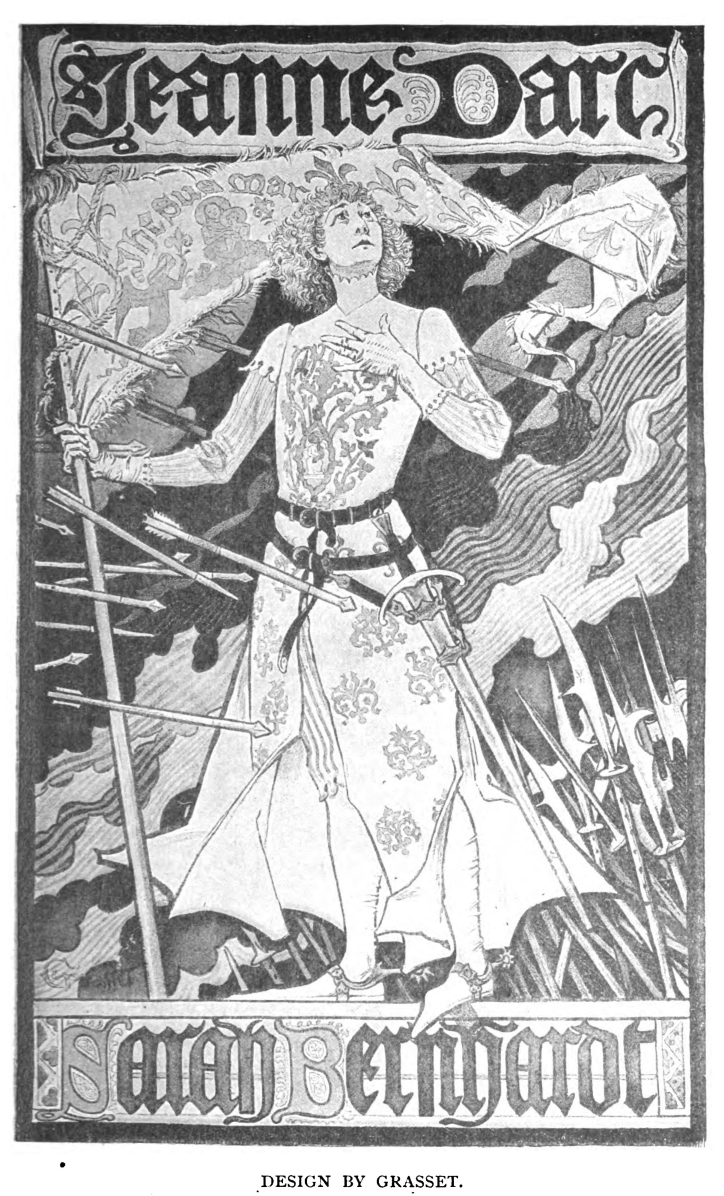
Original

Original
and a shower of arrows, and waving above her head a great silken banner embroidered with the fleur-de-lis. Again, one lingers before the "Fêtes de Paris," attracted by its

Original
fine decorative qualities. Of an entirely different kind is the delicious little poster which the artist did for an exhibition of his own work at the Salon des Cent in 1894; in the naïve simplicity of the thing, combined with its fine decorative quality, there is a hint of Botticelli and the old Italians. The contrast between this poster, slightly archaic as it is, and the realistic "Odéon Théâtre" is complete. The latter represents a charmingly graceful girl, in a delicious modern gown, watching a play. She is accompanied by a highly-proper looking matron, whose self-importance is enhanced by the possession of a handsome dress and a wealth of jewels. Very pretty, again, is the "Librairie Romantique," with the façade of Nôtre Dame in the background. Less worthy of Grasset is the "A la Place Clichy," which, in spite of the majestic old oriental who descants on the merits of an elaborate carpet to a critical European, is somewhat commonplace. Among the other productions of this artist, some of them excellent, but not calling for special description, are the "Histoire de France," "Napoléon," "Chocolat Mexicain," and "L'Encre Marquet," as well as those done to advertise a work on the capital cities of the world, and the exhibition of the productions of French decorative artists held in 1893 at the Grafton Gallery. A bill designed for the South of France Railway Company is curious, insomuch as it is unlike the other productions of its designer. It consists of a series of pleasant little landscapes wreathed in the characteristic fruits and flowers of the Riviera. The colour is striking and the

Original

Original
poster full of sunshine. It is one of the merits of Grasset that he is not, even in what is to him so small a matter as poster-designing, the slave of a single style,

Original
although all his works are obviously from the same hand. Before leaving him, it should in fairness be stated that the lettering of his bills is ever appropriate and decorative. True artist that he is, he neglects no detail whatsoever; in the smallest thing

Original
as in the greatest, he is not merely scrupulous, but even fastidious.
It is no dispraise of Chéret and Grasset to say that the work of Henri de Toulouse-Lautrec is more fascinating than theirs. The designs of the former two are alike in

Original
that they are charming, though charming in manner entirely different; Lautrec's productions, alluring and powerful as they are, can by no stretch of the word be so described. He does not seek to attract you by joyousness of colour or grace of pattern, but rather to compel your attention by the force of his realism or the curiosity of his grotesqueness. For his posters are at once realistic and grotesque; they are delineations of life as seen by a man who, possessing the most acute powers of observation, is poignantly impressed by the incongruities of modern life, the physical peculiarities of modern men. He has some points of similarity with Hogarth, with Rowlandson; and the like, but his art is quite non-moral; he has no mission to depict vice as either hideous or ridiculous. His extraordinary "Reine de Joie," perhaps the most powerful, and certainly the least agreeable, of his posters, is a statement of fact rather than a criticism. This great bill, owing to the vehemence of the expression on the faces of the three people it represents, to the wonderful vigour of its line, to its extraordinarily effective, though simple, colour, is one of the most powerful designs of the kind ever accomplished. It may be doubted whether any book has been advertised in so unforgettable a manner as La Reine de Joie.
For the Paris café chantant artiste who possesses the charming name of Jane Avril, this designer has devised a grotesque decoration, which could not fail imperiously to call attention to her talents as a dancer. Inspired it may be by her name, it may be
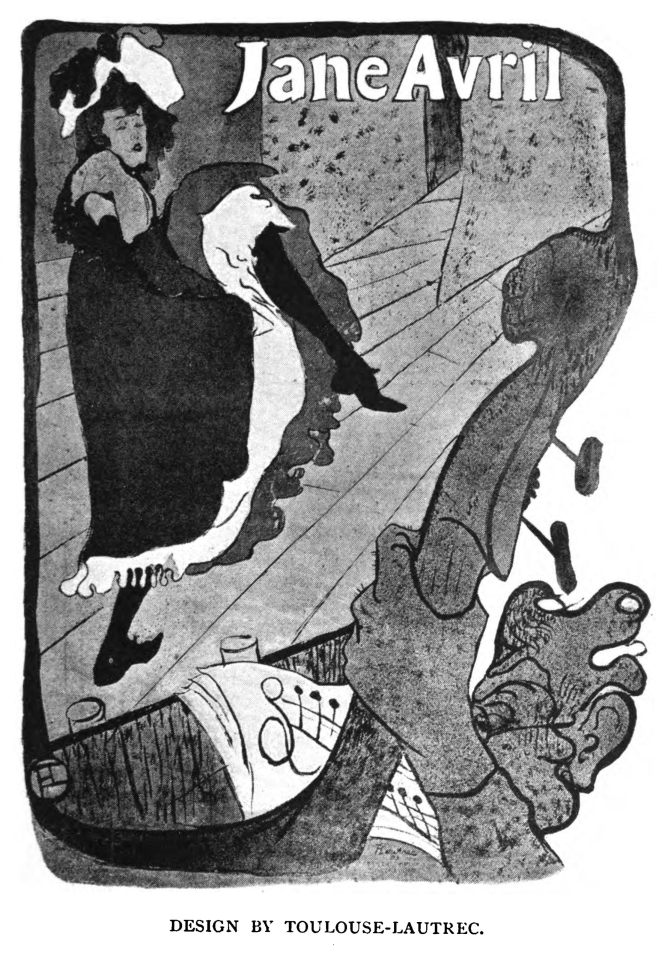
Original
by a happy accident, Lautrec has employed a scheme of colour in which are found the pale

Original
tulip. Once having seen this work, the name, and indeed something of the personality, of Jane Avril is impressed on one's mind. Moreover, one easily recalls this unassuming poster vividly, when works of art, consecrated by the admiration of generations of critics, are quite forgotten, or only faintly remembered. No man of more passionate and curious talent than Aristide Bruant has ever devoted himself to the business of light amusement, and it was no doubt quite congenial to Lautrec to advertise the performances which he gives in his cabaret. Again, the artist's picture of another entertainer, Caudieux, represented in the act of quitting the stage, is masterly for its indication of movement and its powerful characterization. Bad from the advertiser's point of view, but most interesting from that of the collector, is the extremely rare "Le Pendu," a production which for weird and intense tragedy compares to advantage with any of the artist's posters. Scarcely less rare, though by no means so important, is the affiche done to advertise the performances of La Goulue at the Moulin Rouge. A far more agreeable design is the "Divan Japonais," in which a fearful and wonderful girl, accompanied by a man as fashionable as he seems to be imbecile, is represented under the spell of Yvette Guilbert, whose tall, thin figure is seen across the orchestra, her arms, in the famous black gloves, being

Original

Original

Original

Original
crossed in front of her with characteristic nonchalance.
It is in no way astonishing that Mile. Guilbert has strongly attracted Lautrec, and that he has frequently made her the subject of his work. No music-hall performer has, so far, approached this brilliant woman in ability or in artistic prestige. Like Patti and Sarah Bernhardt, she is implored to testify to the merits of every brand of soap or every new perfume; like them her reputation extends beyond the bounds of her native place, and she is the admired of several foreign capitals. If the flower of French art and literature assemble to honour Zola, the proceedings are incomplete without a song from her; if the fastidious De Goncourt is presented with the rosette of the Legion of Honour, what more fitting than that she should deliver a recitation? In some degree she sees the life of modern Paris in the same light as Lautrec; her wonderful delineations are realistic as are his, though their realism is touched with a suspicion of the grotesque. Amongst other things, she has inspired Lautrec to a series of illustrations remarkable alike in drawing and colour; and he has not disdained to design lithographs to adorn the covers of different items of her répertoire. Owing to his kindness, I am enabled to reproduce, as the frontispiece to this volume, a sketch for a poster which he designed for her, but which, unfortunately, has never got beyond the experimental stage. It seems to me a specially interesting example of a remarkable talent applied to a very congenial subject. The posters of Lautrec are something more than works of art; they are human documents strangely eloquent of their moment. For this reason, their value may be more permanent than that of the productions either of Chéret or Grasset, delightfully fantastic as are the former, charmingly decorative as are the latter.
CHAPTER IV.—IN FRANCE: THE WORK OF WILLETTE, FORAIN, STEINLEN
ANQUETIN, BONNARD, IBELS, VALLOTON, DE FEURE, AND McTIVET
It is not for a moment to be pretended that the artists with whom this chapter deals are in any sense members of a single school: they have, indeed, many more points of difference than of similarity. I deal with them together, because, speaking roughly, their designs are saturated with the spirit of the day: their decorations are realistic, rather than fantastic or picturesque. They lean towards Lautrec, rather than towards Chéret or Grasset, but they are in no sense his imitators; some of them, indeed, are actually his predecessors.
Willette is an artist of such astonishing facility and variety, that he has, comparatively speaking, devoted little time to the affiche, and save in one or two conspicuous instances, he has failed to achieve compelling advertisements. And yet his artistic personality is so curious and so powerful that his posters are nearly all interesting to the collector,-more interesting to the collector, it may well be, than satisfactory to the advertiser. Willette is master of several manners. He can be realistic to the point of brutality, symbolical, graceful; while now and then he is almost austerely classical. There are, happily, few posters so impregnated with race hatred as the anti-Semitic bill intended to forward the artist's candidature at the Elections législatives of the 22nd of September, 1889. The design is ugly in the last degree, but it is, nevertheless, strangely powerful. Very different and very much more pleasing is the lithograph in black-admirably composed and executed—which advertised the successful pantomime, entitled L'Enfant Prodigue. The design is at once graceful and dramatic, and it is not surprising that a proof before letters is one of the gems of a collection of the posters of Willette. No more interesting souvenir of an experiment which fascinated both Paris and London can be conceived. Again, the bill advertising the International Exhibition of Commerce and Industry, held some time ago at the Champs de Mars (an unlettered proof of which commands no less than two pounds), is very desirable. The little bill in colours bearing the legend,
"Ainsi qu'un papillon volage,
A qui passe aujourd'hui, demain sera passé.
Laisse-toi cuellir au passage
Papillon d'Actualité,"

Original
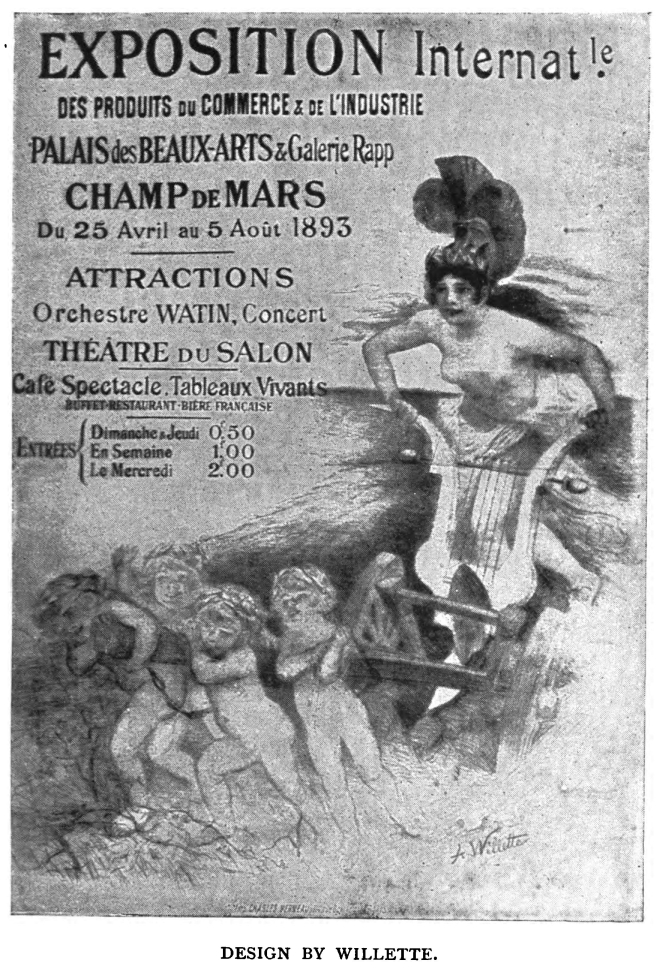
Original

Original

Original

Original
is pretty, alike in colour and pattern, and has already become rare.
Entirely appropriate to its purpose is the "Nouveau Cirque" advertisement, in which clowns, bare-back riders, and performing animals of all kinds-from a frog to an elephant-disport themselves with the utmost abandon. From this to the "Cacao Van Houten," is a far cry. From the point of view of the advertiser, Willette has done nothing better than his life-size study of a Dutch waitress in national costume. The thing is very decorative, and succeeds admirably in attracting attention: another and more complicated design for the same firm is only a shade less successful. This is entitled "La loi défendent le cacao contre le chocolat." The other posters of this artist include the rare "Petite National," the "Evénement Parisien" (which was, I believe, suppressed), the "Courrier Française," the "Exposition Charlet," and the "Elysée Montmartre." The posters of Willette are marked by variety and ingenuity of invention, and there is little doubt that they will be of permanent value as revelations of a talent as individual as it is powerful.
If the artistic poster is an unimportant incident in the career of Willette, it is still more so in that of Forain, whose essays in this direction have been few and far between. Forain is known to nearly every artist in Europe as a great master of black and white.
Few, if any, can approach him in technical dexterity, few can express so much in so few lines. Moreover, to his technical mastery is added a searching power of criticism which gives to his work a further, and a most important, interest. In his desire to depict the truth, the whole truth, and nothing but the truth, he (no doubt unconsciously) becomes a moralist. He depicts life from no sentimental point of view; he can be realistic without seeming to appreciate the tragedy which is of the very essence of realism, so that on seeing one of his illustrations of modern life, one receives, apart from technical delight, a distinctly literary impression. Of his posters, perhaps the earliest is one unsigned and without lettering, representing an illuminated garden, in which a woman is depicted in the midst of an explosion of fireworks. Subsequent to this comes a bill to advertise one of the novels of Dubut de Laforest, which bears the artist's signature. The design which announces Forain's political drawings for the "Figaro" is of slight importance, as it was not originally intended for a poster. In spite of this it is by no means easy to meet with. Of greater interest is the "Exposition des Arts de la Femme." It was, however, only when Forain received a commission to produce an illustrated advertisement for a cycle show that he achieved a really memorable poster, a poster of real charm and rare

Original

Original
originality. The sport of bicycling seems to have fascinated the Parisienne completely, and Forain has made a charming design, in which she is depicted in complete enjoyment of the fashionable pastime. The colour scheme is restrained and delicate, and the production, which exists in two sizes, should certainly be found amongst the treasures of every amateur of the affiche.
The somewhat risky pages of the Gil Bias Illustré have for a considerable time been noticeable to artists, chiefly on account of a series of coloured illustrations by Steinlen. His relentless veracity in depicting the life of the lower classes of the Paris of to-day is almost without rival. No detail of squalor seems to escape him; without a tinge of remorse he proceeds to inform us of the meanest incidents in the tragedy of the poor or vicious quarters of the great city. By reason of a certain emphasis of colour and crudeness of design the art of Steinlen is admirably adapted to the production of such human documents. But it cannot be maintained that, whatever their technical merits, these studies of human misery are other than unpleasant-even painful. It is, therefore, altogether agreeable, when one turns to his essays in the art of the poster, to find his work graceful rather than tragic, urbane rather than mordant. Forsaking his mission of realistic illustration, he becomes gay, dainty, and fanciful as the best of his fellows. Even in a higher degree than the majority of them, he makes his design appropriate to the thing advertised. His decorations are spiced with a certain actuality, and, in being so, insist more effectively on the particular article the merits of which it is their business to proclaim. No better example of this could, I think, be put forward than the "Lait pur de la Vingeannestérilisé," a design which, in view of the material to be advertised, is conceived in the happiest vein. The pretty little girl drinking the milk, so much coveted of the cats which surround her, is less interesting than the animals themselves. The draughtsmanship of the latter is excellent, while there is a hint of that humanity of expression about the creatures which has produced for the work of Landseer so immense a popularity. Not less admirable, and of still greater interest, is the poster designed to advertise the performances of Yvette Guilbert at the Ambassadeurs. Amongst the numerous artists to whom the Sarah Bernharct of the music-halls has given commissions none has been more successful than Steinlen. The poster represents the singer behind the footlights in an attitude pre-eminently characteristic. The thing does not amount to a caricature, as does the hitherto unpublished delineation of Toulouse-Lautrec, but is merely a slightly exaggerated portrait. It is remarkably suggestive of a most alluring and delightful
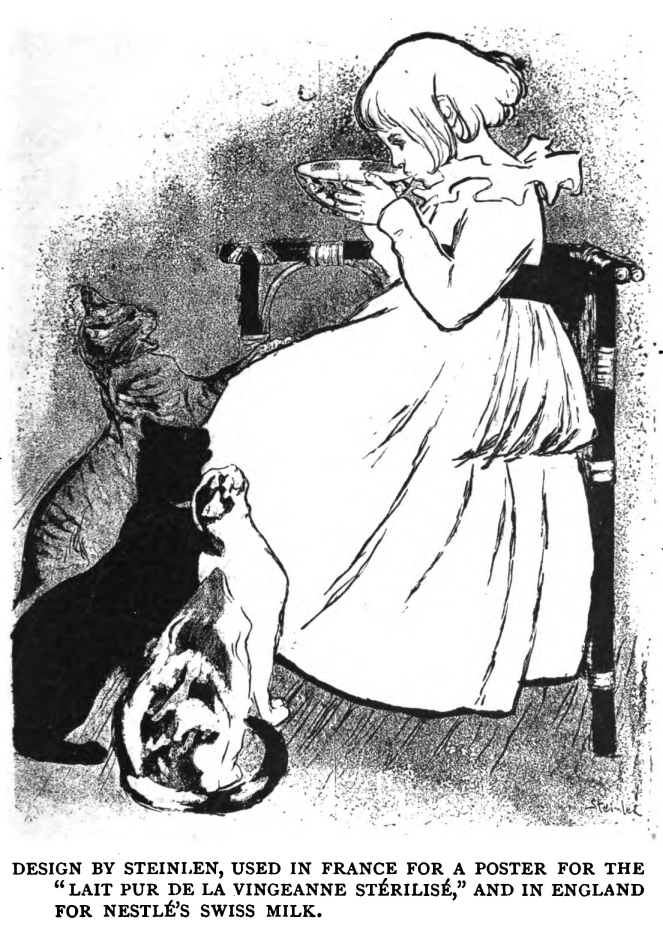
Original

Original
personality. As an advertisement, it must be confessed, it is not all that could be desired. The colour scheme, while very dainty, is not one which insists on its presence on the hoardings, so that the proximity of (for example) a Chéret renders it to some extent ineffective. At the same time, it is one of the most charming designs of the kind in existence, and no collector should fail to possess himself of a copy. It exists in three states: proofs before letters pulled in two tints only, ordinary proofs before letters, and prints after letters. In the former state it is rapidly increasing in value, but, insomuch as the lettering is of the essence of the design, the final state is the most desirable of all. To advertise an exhibition of his own work, Steinlen produced another study of cats, which is almost as agreeable as the "Lait pur." It is in two states: proofs before and after letters. The artist's design for the watering-place, Vernet-les-Bains, is not very important, but his early "Mothu et Doria," in three states, should not be overlooked. Earlier in date than any of the designs I have discussed is the "Trouville" and "Le Rêve." The latter is a pretty composition reproduced in chromotypo-gravure. While the posters of Steinlen are not so striking on the hoarding as those of some of his contemporaries, they are of the highest artistic interest, and will no doubt take a place second to none in the affections of many collectors. It is significant that already the rarest of them are by no means easy to procure.
The art of Ibels is as little comprised in the poster as that of Steinlen. It is happily characteristic of young artists of the present day, both here and in France, that painting is not the only god of their aesthetic adoration:
they experiment in many mediums, and it is really remarkable in how great a number of such experiments they succeed. What is generally true, is especially so of H. G. Ibels. Like Grasset, he has held an exhibition of his pictures at the Salon des Cent; he has made his mark in the galleries of the Champs de Mars; he has designed the covers of several pieces of music, and of a volume of poems by his brother, entitled "Chansons Colorées"; in addition, he is well-known as a book illustrator. His point of view is somewhat akin to that of Toulouse-Lautrec: he is passionately interested in his own moment, and depicts modern life with similar insistence on its ugly and grotesque aspects. And yet Ibels rarely fails to be decorative, and his style is the outcome of his own artistic personality, rather than the result of study of the work of other men. In his posters he has been conspicuously successful; so much so, that it is difficult to point to a single failure, though, it must be remembered, that as yet his productions have not been very numerous. It is possible

Original

Original
that with some the "Mévisto à l'Horloge" will be deemed his best design, but it can in no sense be considered his most original. It represents the actor as Pierrot, and is graceful and pleasing rather than characteristic; indeed, one would almost think that in designing it the artist had been at pains to conceal his personality. Nor is the "Salon des Cent"-a charming and delicate little lithograph-in spite of the ingenuity and fantasy of its grouping of Pierrot, Harlequin and Columbine, the most noteworthy of Ibels' posters. We see him at his most original, in an advertisement for the illustrated paper entitled "l'Escar-mouche," to which he, together with Lautrec, Vuillard, Willette, and Anquetin, contributed drawings. It represents a café of the lower class, such as abounds in the workmen's quarter of Paris. The enormously fat patron enthroned behind the metal-topped bar, the waitress, cloth in hand, clad in her slovenly dress, the ouvriers in typical blue blouses, are studies in which accurate portraiture has been but slightly sacrificed to grotesqueness. The whole scene is admirably conceived, and the colour scheme, though very restrained, is certainly telling. Those who can do so should secure a proof before letters of this work, for the lettering is, I believe, not by the artist himself, and mars the effect of the design, although not in a very marked degree. Another interesting bill is that done for Mévisto's performances at the Scala music-hall; this is of great size and striking originality. But if grotesque force, and the power of reducing scenes of modern lower-class life into decoration, are Ibels' most pronounced characteristics, he can produce posters of the suavest charm. Amongst all the affiches I know, none seems to me more delightful than this artist's "Irène Henry." The café chantant singer whom it represents is justly a popular favourite with the Parisian public from the fact that she infuses into her performances no small amount of personality; moreover, her art is marked by grace and finish. Those who would see her as she appears to audiences at the Horloge, without going there, have only to look at Ibels' poster. With the rarest felicity, he has caught her physical individuality. She is represented in the act of singing in the open air to a crowd in the café, lighted by the familiar circle of white lamps. The line of the figure is most expressive: violet is the predominating colour. This poster is worthy a place in the French music hall series, which includes those designed by Lautrec for Jane Avril, by Steinlen for Yvette Guilbert, and by an artist whom I am about to consider, Anque-tin, for Marguerite Dufay.
So far as I know, Anquetin has only produced two affiches of importance, but each
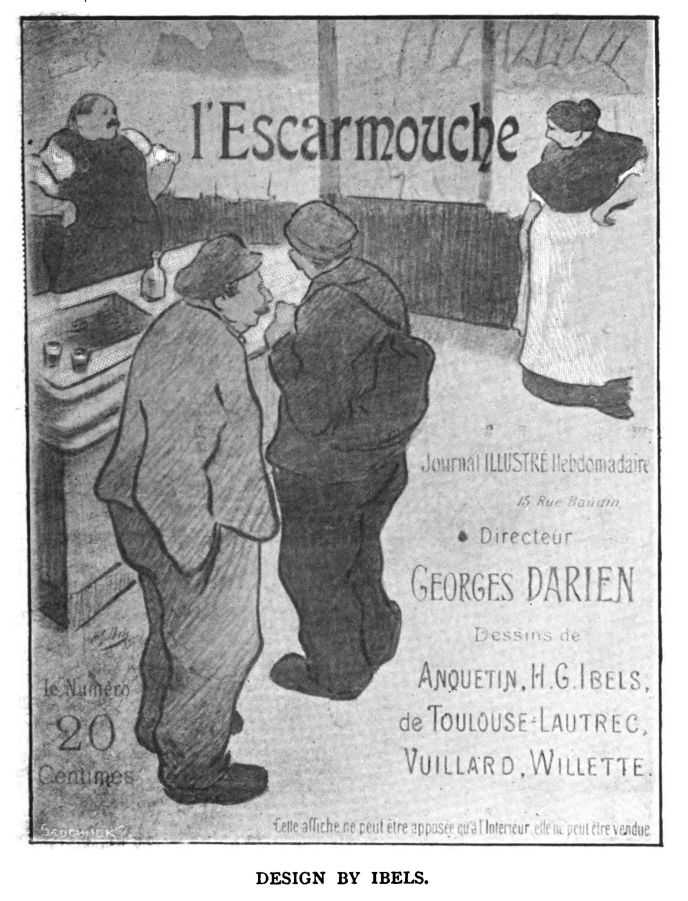
Original

Original
of them is worthy of the closest attention. The design for Marguerite Dufay is a piece of triumphant vulgarity. The subject is a very simple one; it is merely a woman of almost impossible fatness who performs at various Parisian music-halls on the trombone. Having stated this, one has, however, given no idea of the extraordinary qualities of this bill. It is safe to say that, once seen, it will never be forgotten; it should have made the fortune of the performer whom it advertises. The mirth of the thing is victorious and infectious; one seems almost to hear the coarse laugh; the ample body in the green dress seems to move as one stares at it. In line, in movement, this poster is, from a certain point of view, a veritable masterpiece. An advertisement which is, it seems to me, altogether more worthy of Anquetin's great talent is one designed for "Le Rire," a recently issued journal. It is an extremely fine lithograph in a single printing, and, as at present it can be procured for a few shillings, it should be in the possession, not only of those who care for posters as such, but also of all who are amateurs of the beautiful art of lithography. In the foreground is the figure of a huge man in mediaeval costume, which, while touched with the grotesque, is splendidly flamboyant At his side he carries a large portfolio, adorned with a grinning mask, while his hands, which are admirably drawn, point towards a crowd of grinning pigmies beneath him. Every one of the crowd is extremely expressive, and the effect of the whole production is enhanced by very excellent lettering. It would be difficult to meet with two affiches more interesting than the "Marguerite Dufay" and "Le Rire," and they place Anquetin amongst the masters of the art of the poster.
If Anquetin is an artist of marked originality, so, in a manner totally different, is Pierre Bonnard. Save in the small number of his posters, he resembles Anquetin in hardly anything; on the other hand, his work has points of similarity with the later work of Lautrec. The posters of both these artists are decorative in a curious and somewhat similar sort of way, decorative in spite of their marked grotesqueness. Between the "Confetti" of Lautrec and the "Revue Blanche" of Bonnard there is a distinct decorative affinity. As both of them are dated the same year, 1894, it is needless to suggest that either of these intensely personal artists has derived anything from the other; there is, indeed, no evidence whatsoever of imitation, or even influence. Of the two best-known posters of Bonnard, the "France Champagne" is the earlier in point of time, having been published in 1891. It is a lithograph in three colours, and represents an extraordinarily fantastic, and extremely décolletée girl, who holds in one hand a

Original

Original

Original

Original
closed fan, and in the other an overflowing glass of champagne, which tumbles about her in a great cascade of foam. The background is yellow and the girl's dress red, while the upper part of the design is occupied by the arms of Paris and the text in large letters. The draughtsmanship is curious and vivacious, and the colouring conspicuously successful. This poster is not large, measuring as it does, only thirty-two by twenty-nine inches. The "Revue Blanche," though of nearly the same size, is much more complicated. In the foreground is a woman in huge hat and cape, which partly conceal her face, at whom an extraordinarily grotesque street urchin points his finger. The background is composed of innumerable advertisements of the revue, which a man in a great coat and silk hat, with his back to the spectator, is reading attentively. All the figures are in a sort of slate colour. The legend is admirably introduced into the foreground by means of huge white letters. Owing to the curiosity of its decoration, this specimen of Bonnard's work is a most desirable possession for the collector.
It has been the good fortune of Valloton to produce at least one poster which is excellent from every point of view. Nothing more appropriate to the advertisement of a frivolous burlesque than his "Ah! la Pé. la Pé, la pépinièré" could well be imagined. It represents a characteristic audience at a

Original

Original
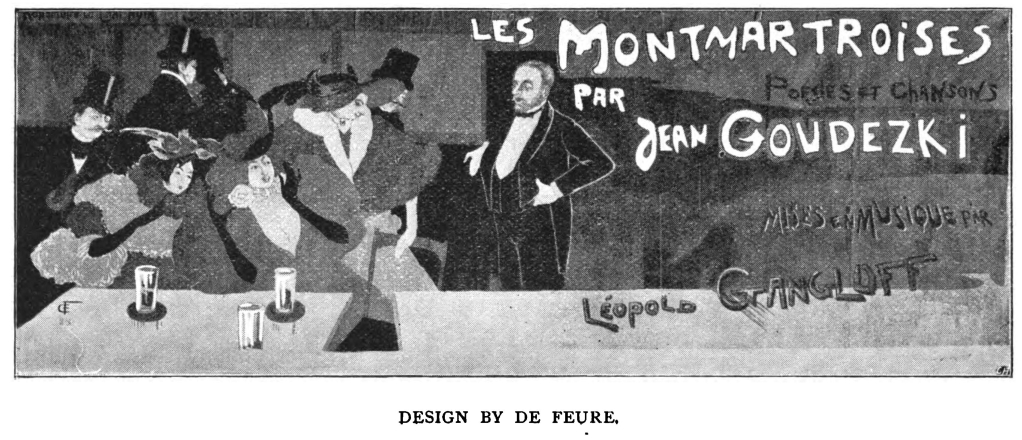
Original

Original
theatre convulsed with laughter at what is taking place on the stage. The variety of expression on the faces of the spectators is infinite, and the effect of the whole thing is as mirthful as may be. From the advertiser's point of view, I can conceive nothing more completely satisfactory. It exists in colours and in black, and the latter is the rarer. The same artist's "Carte de Paris" would seem already to have become scarce. It is a large lithograph in one colour; an example was shown at the Poster Exhibition at the Royal Aquarium. There is also a large address card designed by Valloton for M. Sagot. While this is not actually a poster it almost amounts to one, and were it to be executed on a large scale, it would doubtless be most successful. It is to be hoped that Valloton, encouraged by his universally recognized success in the art of the poster, will not altogether give up its practice in favour of those other branches of art in which he is distinguished.
The style of De Feure, if not so well adapted to poster work as that of some of his contemporaries, is nevertheless very interesting. His most characteristic effort is, perhaps, the "Salon des Cent, 5e Exposition." This design is very modern and very fantastic. It exists in three states—proofs before letters on vellum, proofs on Japanese paper, and ordinary prints. The proofs before letters command very good prices. Amongst the other posters of De Feure is that done for the performance of the singer, Edmée Lescaut, at the Casino de Paris; for the newspaper "Le Diablotin"; and for the "Paris Almanach." In addition, we must not overlook the pleasant little design for the contents bill of a special issue of "To-Day."
The posters of Lucien Métivetare of very unequal merit. On the one hand the designs done by him for Eugénie Buffet, in her realistic répertoire of songs, are extremely distinguished. While, on the other, I could point to examples by this artist which are utterly unworthy his talent. Amongst Métivet's earlier works are "La Famille, journal hebdomadaire illustré," and "L'Hygiène." A more recent bill advertises "Les Joyeuses commères de Paris," but Métivet's talent is seen at its best in the Eugénie Buffet advertisements, two studies worthy a place amongst the best posters which have come from the hands of contemporary French artists.
CHAPTER V.—IN FRANCE: THE WORK OF GUILLAUME, PALEOLOGUE, CHOU-BRAC
BOUTET DE MONVEL, AMAN-JEAN, SCHWÆBE, SINET, JOSSOT, MAYET, AND OTHERS
Prominent among the French designers of posters with whom I have not previously dealt is Guillaume, an artist widely known in England by reason of the admirable illustrations which, from time to time, appear in our periodicals. Save Chéret and Choubrac, few artists have done so much poster work as Guillaume, and not many have maintained so high a level of accomplishment. Vigour, vivacity, and high spirits, rather than beautiful design and fine colour, are the characteristic qualities of posters by Guillaume. He is, it seems to me, seen at his best in the admirable "Extrait de Viande Armour," which is reproduced here. In its way, and looking to the thing to be advertised, nothing better has been done. The gigantic "strong man," with his huge torso, colossal arms and legs, holding a tiny teacup in his immense hands, is not easily forgotten. The expression on the man's face is inimitable, and the accessories, such as cannons and dumbbells, are most appropriately chosen. The "Chapeaux l'elion" is a more complicated design, representing a crowd of men wearing hats of every conceivable shape. The colour of this design is very good, but its chief merit lies in the facial expression of the different members of the crowd. It would be impossible to conceive any single person in a hat other than the one he is wearing. In another excellent poster we are presented with a very fin-de-siècle young lady riding astride a stork which bears her rapidly through space. It would be hopeless to attempt anything like a complete list of Guillaume's posters, but among the most recent are the following, all of which deserve the attention of the collector: "Dentifrices du Dr. Bonn," "Gigolette," "Old England," "Le Pôle Nord," "Cycles Vincent fils," "Le Vin d'Or" (in two sizes, unsigned), "Parfumerie Diaphane; le Diaphane Sarah Bernhardt," "L'ouvre de Rabelais par J. Gamier," and "Ducreux et Giralduc (Ambassadeurs)".
Although a Frenchman, the work of Jean de Paleologue, or "Pal," as he is more frequently called, is perhaps better known to the Londoner than to the Parisian. His

Original

Original

Original
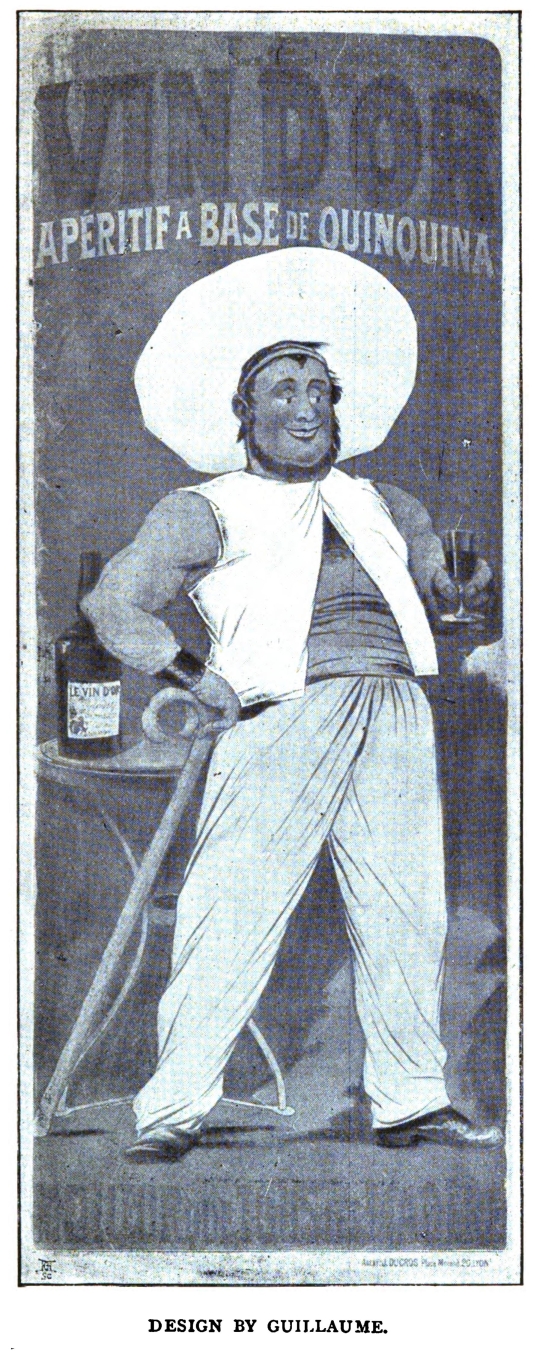
Original
bright and flippant posters can be seen any day on the London hoardings, and I have, therefore, purposely selected for reproduction two examples in his less usual manner. The "Lucile Wraim" is of an elegance to which Paleologue does not often attain, and would be distinguished in almost any collection of posters. "The Euskal Jai Parisien," besides being a good advertisement, is curious on account of its subject. Collectors who would possess a more typical example of Paleologue's work would be well advised to secure one or more of his music-hall series or his "Cabourg," an advertisement for the watering-place of that name. It is a large lithograph in five colours, and represents a very charming lady who, while bathing, is bent upon displaying her charms to the utmost. While Paleologue can in no sense be compared to Chéret in his gift of diffusing joyousness and gaiety, his work is undoubtedly "chic," and rarely fails in its first business of advertisement. Some of his posters have become difficult to procure, notably one designed for a Drury Lane pantomime some few years since.
No artist, save Jules Chéret, has been more indefatigable in the making of posters than Choubrac. The list given in M. Maindron's book is a long one; that given in the catalogues of M. Sagot is still longer. The posters of Choubrac do not seem to have received so much attention at the hands of collectors as those of some of his better-known contemporaries. At the same time, not a few of them are interesting and rare. The bill done for the "Fin de Siècle" was suppressed, and, as a consequence, is in great demand. It exists in four states, three of which, in good condition, command no less than fifty francs. Merely to give the names of the music-halls and theatres for which Choubrac has worked would take up the better part of a page, while a list of the artistes whom he has advertised would be still longer. Amongst the most noticeable of his recent bills are the following: "Eldorado. Y'a pas d'erreur," "Folies Bergère. Armand Ary," "Folies Bergère. Programme," "Folies Dramatiques. Miss Robinson," "Moulin Rouge. Au Joyeux," "Neuilly-sur-Seine. Fête des fleurs," and "Gaieté. Rosa et Josepha" (in two states).
An artist more unlike Choubrac than Maurice Boutet de Monvel it would be assuredly impossible to find, and the fact that these names are in juxtaposition must be taken as proof that no systematic arrangement has been attempted in this chapter. Boutet de Monvel is a painter of European reputation. His fame as an illustrator for, and a delineator of, children stands very high. His studies of child-life are unlike those of any other artist. They display the keenest observation and, as Mr. Pennell has rightly observed, one finds in them not a line without

Original

Original
meaning. Boutet de Monvel has, I believe, produced only three posters. Two of them are among the most charming things seen on the Paris hoardings for

Original
many a long day. Both of these are comparatively small. That which is earlier in date, "Petite Poucette," was originally designed as a cover for a piece of music, but, when reproduced on a larger scale, was found to be thoroughly effective as a poster. More dainty, if not more characteristic of the art of Boutet de Monvel, is the "Pâte Dentifrice du Dr. Pierre." In this design, one of the prettiest and most delightful little ladies in the whole Monvel gallery of pretty little ladies insists on the merit of the tooth-paste which, if it be half as good as she is charming, must be excellent indeed. Every artist knows his own business best, but one can only hope that, in what leisure he can snatch from his work in paint and illustration, Boutet de Monvel will place the collector of posters under new obligations to him. His note as a decorator of the hoardings is as distinct as it is agreeable.
A very interesting figure in modern design is undoubtedly Carloz Schwæbe. One of the leading lights of that curious institution the "Salon Rose + Croix," it would indeed be curious if Schwæbe did anything commonplace. His posters are as remarkable as those other productions with which he has delighted some and puzzled not a few. Mystic, slightly archaic, they are the work of a man of poetical temperament who has chosen the graphic arts instead of literature as his means of expression. The two posters from his hand are very decorative in their strange way, and contain passages of great beauty. In the
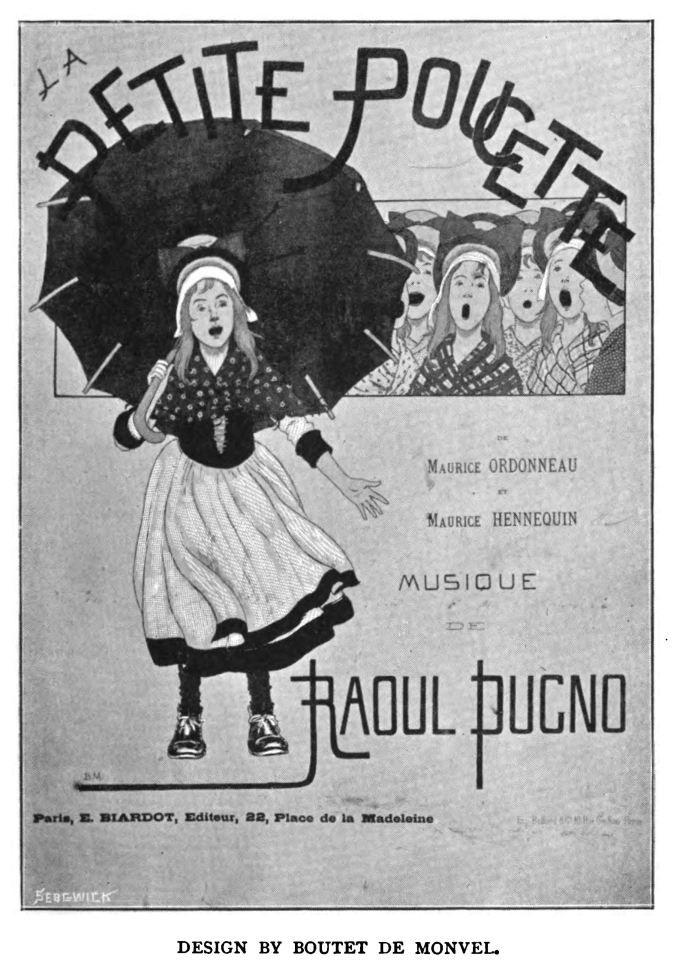
Original

Original
kneeling woman is remarkably impressive, while the irises amidst which she kneels are beautifully drawn. The lettering of this poster is most original, and the designer has evidently taken great pains with it. It is a lithograph in two colours, and measures forty-two and a half by thirty-one and a half inches. Schwæbe's larger poster, the "Salon Rose + Croix," is in one colour only, and is a good example of his work. So far this curiously-gifted artist has confined himself to advertising a concert and a picture show; it is not to be expected that he will ever condescend to soap or extract of beef. Another of the Rose + Croix men, Aman-Jean, has done a poster for the Salon which rivals in curiosity the productions of Schwæbe himself.
A little advertisement which had, it may well be, some influence on the poster movement in England, was that by which André Sinet advertised an exhibition of his own works held at the Goupil Gallery in 1893. This was an attractive little bit of design of which the colour was very agreeable. In addition to it, Sinet has done the inevitable poster for Yvette Guilbert. Another painter of talent who has made an advertisement for an exhibition of his own work is H. Guérard. It represents a group of ravens and is in poker work. It would appear to be rare, as it is quoted in none of the catalogues. A copy, exhibited at the Aquarium in 1894, is in the collection of Mr. Ernest Hart. Still another artist who

Original

Original

Original
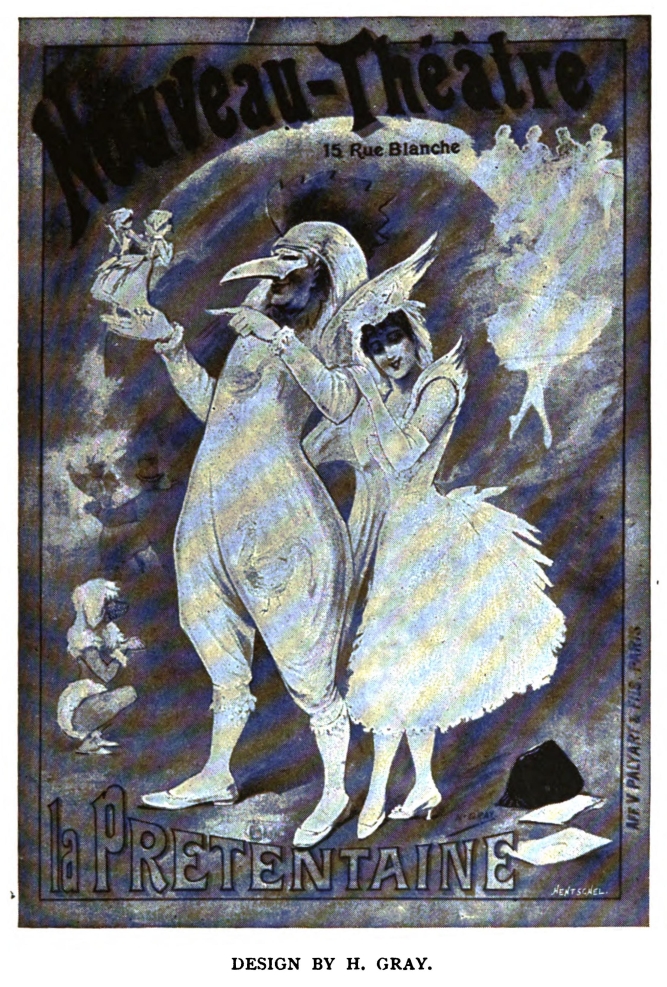
Original
has, I believe, done only one poster, is Goissaud. His design was to advertise the "Société des miniaturistes et enlumineurs de France," and is a lithograph in one colour. Among the Salon des Cent series we have, besides the admirable posters of Grasset and Ibels already alluded to, a very grotesque and effective little design by Jossot. It represents an amazing old gentleman of weird aspect, in cocked hat, paying his franc for admission to the exhibition. Of its kind it is effective enough. Another, by Cazoly, with a curious portrait of Paul Verlaine is reproduced here.
It is certainly with no view to hurt the feelings of those artists whose names do not head this chapter that they are represented by a mere et cetera. It must be understood that one of the least polite of contractions, in this case, involves no discourtesy whatsoever.
For example, I may instance such able work as Grün's "Le Carillon: cabaret artistique." Few posters are more vivid or more actual than this. The price of it is a matter of pence, and it should certainly not be neglected by those whom it amuses to collect the affiche illustré. Grün, in addition to "Le Carillon," has produced "Poléon-Revue: Décadent's Concert," and in addition a design for an insurance company. One of the most charming of the more recent French posters is one by H. Gray, dealing with "La Prétentaine," a play produced some time ago at the Nouveau Théâtre. In addition he has advertised "La Bonita" at the Cirque d'Eté, "Les Mousquetaires," at the same place, "Les Saltimbanques" at the Cirque d'Hiver, and the bal masqué at the Théâtre de l'Opéra. The last is perhaps the best known of his affiches. Among others, Bac has done a poster for Yvette Guilbert at the Horloge, which is signed and dated 1892. The bicycling craze has called into existence a perfect torrent of posters, and Bac, together with Gray, Guillaume, Lunel, and Paleologue, have produced posters of more or less interest. A gentleman who is sufficiently modest not to state his name, did a design which called forth the wrath of the authorities. Whereupon an artist called Lepur designed an affiche bearing the significant legend, of which this is a translation: "Grand choice of vine-leaves (fig-leaves) of all sizes for posters, as demanded by the virtuous journals, the 'T(emps '), the 'G(aulois '), and the 'D(ébats ')."
The following is a list, with the names of typical examples of their work, of some other French artists of distinction who have designed posters: Barbizet ("La branche cassée"), Bouisset (F.) ("Bazar de l'Hôtel-de-Ville," "Exposition de jouets," "Chocolat Menier"), Desicy (H.) ("Un héritage, roman"), Dutriac ("Ambassadeurs: Danseuses Espagnols"), Faria ("Ba-ta-clan: [Illustration: 0189] Paulus"), Dufay ("Portrait,") ("Les Rey Nol's)," Galice (G.) ("Concert parisien: Esther Lekain," "Fête des Fleurs," "Paulan Brébion," "Scala: Jeanne Bloch"), Guydo ("Eldorado: Aimée Eymard"), Honer ("Concert parisien: Bonnaire"), Hope ("Gaieté: Tour de Nesle"), Huvey ("Gras-side"), Lamy (L.) ("Le capitaine Henriot, opéra comique," "Théâtre national lyrique"), Lebégue (L.) ("Bals travestes et tableaux vivants"), Lefèvre (L.) ("Cacao lacté," "Electricine," "L'hiver à Nice"), Levy (E.) ("Châtelet Michel Strogoff," "Cirque d'Hiver: Caravane dans le désert," "Folies Bergère: Vue de la salle," "Petit national: Le prince Mouffetard"), Meunier (G.) ("Papier à cigarettes Job," "Parfumerie Edéa," "Le Sahara à Paris: Champ de Mars"), Truchet (A.) ("Cabaret des Quat'z' Arts," "Eldorado: Alice Berthier.")
It will have been noticed already how great apart the music-hall and the café chantant play in the history of the pictorial poster. Yvette Guilbert has been the cause of a baker's dozen of affiches; Anna Thibaud (that charming singer of the songs of Béranger); Anna Held, with her curious manner, and still more curious appearance; Irène Henri, of intense personality; Jane Avril, and May Belfort; to say nothing of Aristide Bruant, of Caudieux, of Paulus, and the rest of the school who have made the music-hall stage of France a matter of no small importance

Original
in her social life, have been favourite subjects of the designers of posters. It has always been held that the career of an actor, in consideration of its evanescence, is not

Original
without a certain pathos. It is true that we remember, through the gossip of their friends, Garrick and Mrs. Siddons, Talma and Rachel, but even these are uncertain phantoms lingering in the haze of memory. Only yesterday they were intensely actual, to-day they are not more real than Burbage and Betterton. After all, the history of the actor's art is not without its immortals. Macaulay's schoolboy could doubtless have related the compliment of Dr. Johnson to Mrs. Siddons: the latest escapade of the great Sarah is the joy of the paragrapher. The music-hall, however, has still no artist in any country (save, perhaps, the unforgettable Yvette) who has much chance of permanent remembrance. But when the toil and moil of existence is ended, when the singer has sung his last song, it may chance that he will be remembered because some collector of such unconsidered trifles as picture posters has placed in his portfolio a work of Chéret or of Lautrec.
To turn from the music-halls to the great railway companies is an emphatic transition, and yet the former, no less than the latter have done much to encourage the artist to apply his talent to the affiche. The Great Western Railway Company have illustrated at their stations and in their carriages, by means of photography, all that is romantic and interesting in the country through which their line runs. And, again, the great lines of the United States have brought into vogue vast systems of pictorial advertisement. Their opportunity was undoubtedly a magnificent one. For subject

Original

Original
matter they had some of those vast natural developments which appeal to mere man as absolutely terrific. The waterfall, splashing itself into luminous dust, the immense and silent mountains, the lakes which are seas, the vasty canons which occur in different parts of the States, inevitably appeal to the imagination. It is therefore not wonderful that the great lines of America have preferred literal and exact illustration to fantastic delineation. The railways of France, on the other hand, have employed to no inconsiderable extent the artist to figure the beauties of the places at which they have stations. Amongst the most important French designers who have worked at the railway affiche are:-Fraipont (G.): ("Chemin de fer de l'Etat: Bains de mer de Royan": "Royan sur l'Océan," "Chemin de fer d'Orléans: Excursions en Tou-raine": "Excursions en Touraine et aux châteaux des bords de la Loire," "Chemin de fer de l'Ouest: Argenteuil à Mantes," "Cie de l'Ouest et de Brighton: Fleurs, fruits, primeurs à destination de Londres," "Paris à Londres (L'Angleterre et l'Ecosse)" "Chemin de fer du Nord: Excursions à la mer," "Chemin de fer de l'Est: Royat," "Chemin de fer de l'Ouest: Bretagne, Normandie," "Normandie et Bretagne," "Chemin de fer de l'Ouest à Brighton: Paris à Londres," "Chemin de fer du Nord: Anvers, Exposition universelle.") Ochoa: ("Club Train," "Méditerranée," "Express (Cie Int. des wagons-lits)," "Orient-Express," "Peninsular-Express"). Hugo d'Alési (affiches simili-aquarelles): "Paris, Lyons, Marseilles, Algérie," "Genève," "L'hiver à Nice," (two subjects), "Lac de Thoune," "Mont Revard," "Le Mont Rose," "Le Puy," "Tunisie," "La Turbie," "Uriage-les-Bains," "Chemin de fer du Midi: Pyrénées," "Chemin de fer d'Orléans: Excursions en Auvergne" (1894), "La Creuse et l'Indre," "Chemin de fer de l'Ouest: Dieppe," "L'Auvergne (Orléans)." Lefèvre (L.): "Nord. Eté a Cobourg," "Orléans Excursions aux Pyrénées," "Bains de mer du Golfe de Gascogne," "Ouest Excursions sur les côtes de Normandie, en Bretagne, et à l'île de Jersey." Among other designers for French railway companies and watering-places may be named Orazi, whose "Trouville" poster is reproduced on p. 181, Balzer, Baylac, Japhet, and Ogé.
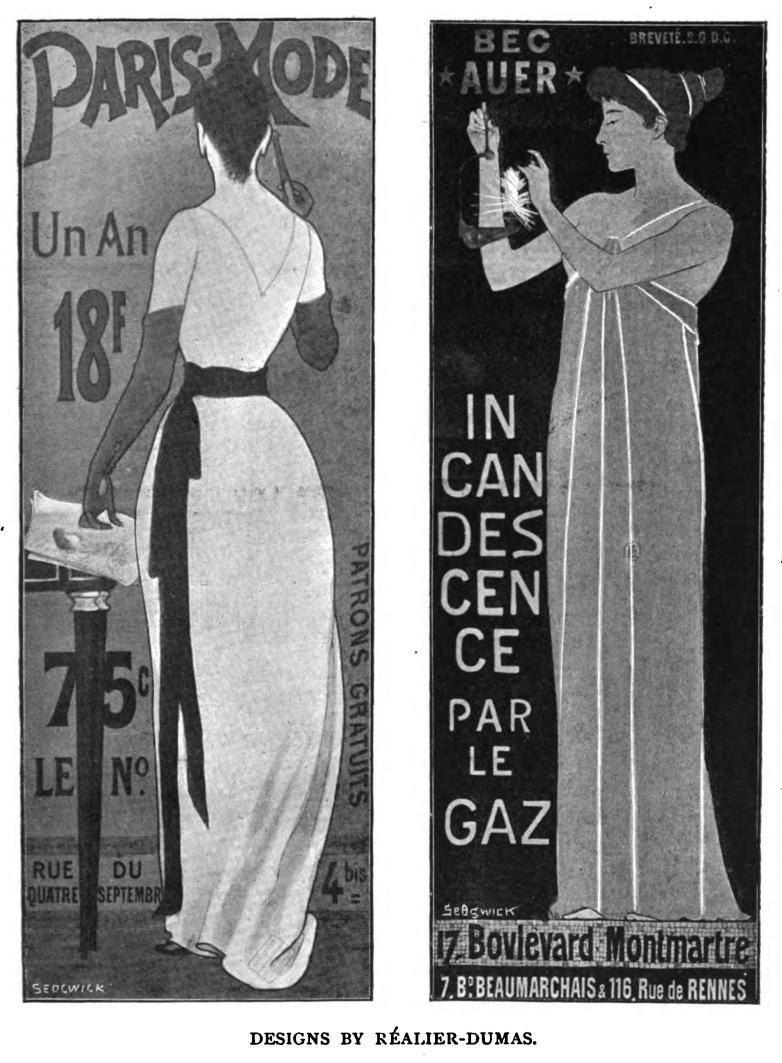
Original

Original
CHAPTER VI.—IN ENGLAND: FROM FRED WALKER TO DUDLEY HARDY
While the pictorial poster undoubtedly existed in England previous to the production of Fred Walker's "Woman in White," its artistic qualities were conspicuous by their absence. No body of artists who designed posters, such as that of which Ga-varni was one in France, is to be met with in the history of English art until the present day. While, as Mr. Spielmann reminds us in a recent magazine article, Mr. Godfroy Durand and Mr. Walter Crane had both attempted the artistic affiche previous to Walker, the efforts of neither made a pronounced impression, nor were they productive of permanent results. The work of the first of these three artists announced the appearance of the then newly-founded "Graphic," and that of Mr. Walter Crane proclaimed the merits of a brand of lead pencils. It is interesting, as an example of Mr. Crane's immense versatility in decorative design, that he should be among the pioneers of the poster movement in this country. That his early effort was overshadowed by Walker's very imposing work is not a matter of surprise. From the first, Walker appears to have been deeply impressed by the possibilities of the hoardings as a free art gallery. To use his own words, as quoted by Mr. Spielmann: "I am impressed on doing all I can with a first attempt at what I consider might develop into a most important branch of art." How Walker's view has been realized the mere existence of this book is sufficient to prove. This design, which was done to advertise Wilkie Collins's novel, "The Woman in White," represents a magnificently-draped female figure stepping through a door out into the night. With one hand she opens the door, with the other she imposes silence on some person unseen. This was cut on wood by W. H. Hooper, who also engraved the small block we are permitted to reproduce here from "The Magazine of Art." The design is in black and white, and has the limitations from the advertising point of view of black and white work; but, apart from this, it is in every way a work which could not fail to impress the passer-by. "The Woman in White" is, unfortunately, Walker's sole essay in the art of the poster; on the other hand, Mr. Walter Crane has produced a series which, we may hope, has yet to close. It would seem that over ten years elapsed between his first and second attempts in the art of the poster. We meet with him for the second time in a design in blue and yellow

Original
which advertised the Covent Garden Promenade Concerts given in 1880. This has become extremely rare, and the artist himself does not, I believe, possess a copy. Following the Covent Garden bill was one announcing the performances in London of the Paris Hippodrome Troupe. This is merely an enlargement on a vast scale of a classical drawing intended to adorn a book describing the show, but it is distinctly interesting, more so, it seems to me, than the pretty little coloured thing-a window-bill, rather than a poster-which advertises Hau's champagnes. Other posters by Mr. Crane deal with an exhibition of his own works, with various insurance companies, with the "English Illustrated Magazine" (an enlarged version of the cover), and the exhibitions of the Arts and Crafts Society. It will be seen that Mr. Crane's contribution to the art of the poster is a very substantial one, and if his designs do not always fulfil the sweet uses of advertisement, they are generally marked by fine taste. It is a matter of common knowledge that Professor Herkomer has left hardly any art or craft untouched, and it therefore goes without saying that he has left some of them unadorned. To succeed as painter, etcher, carver, musician, poet and playwright, lecturer, and actor is not given to mere man. Professor Herkomer's posters cannot, I think, be considered among his more fortunate performances. That done for "The Magazine of Art" does not lack a certain feeling for composition: the weird

Original
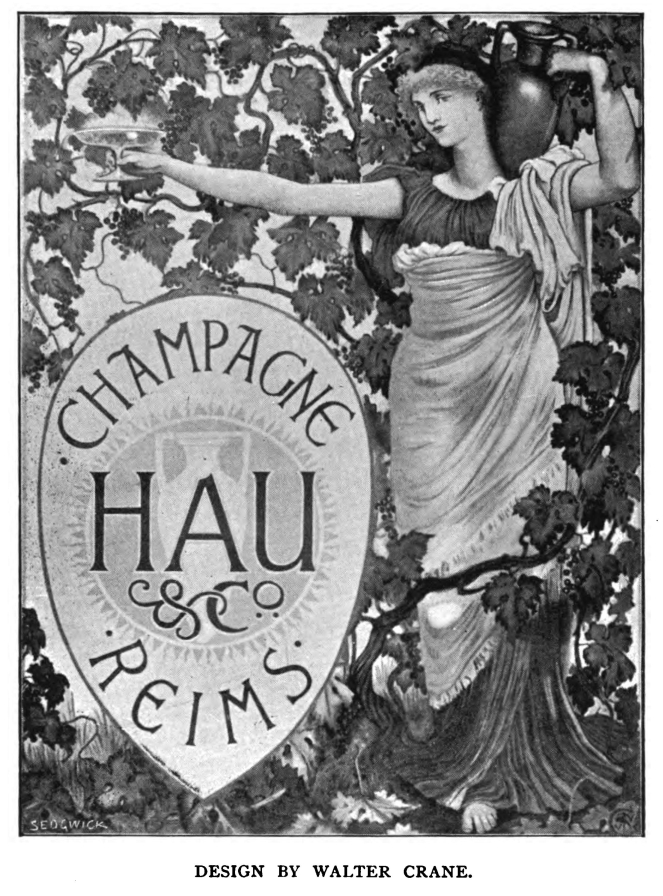
Original
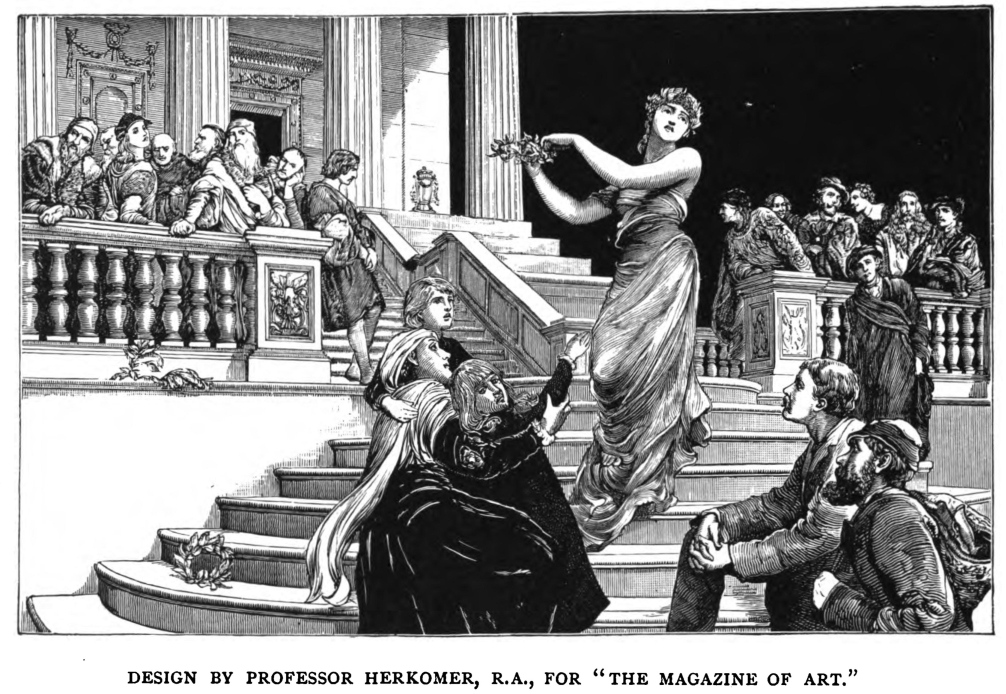
Original

Original
creature who told us that "Black and White" was coming seemed to me to lack both dignity and grace, and, moreover, to possess very few compensating qualities. Amongst other posters by Professor Herkomer is one for his own exhibition, and one for an exhibition of pictures recently held at Oxford.
It should be noted that while most of the mural decorations of Mr. Crane and Professor Herkomer are, strictly speaking, posters, in that they were designed for the hoardings and for the hoardings alone, a great many designs and pictures by eminent artists have been reproduced and posted contrary to the original intention of their designers. The most prominent of these is, of course, Sir John Millais' famous "Bubbles," on the reproduction of which enormous sums have been spent. The thing is pretty enough, but cannot compete as an advertisement with a really good poster properly so called. Of course the name of Sir John Millais was one to conjure with, and the success of the thing has been, doubtless, great. But it is not an experiment one cares to see frequently repeated. Messrs. Pears were more happily inspired in the commission which they gave to Mr. Stacy Marks to produce a bona fide poster. His "Monks Shaving," seems to be most excellently conceived, and, indeed, to be the most interesting of Messrs. Pears

Original

Original
gallery of illustrated advertisements. Art has certainly played a very prominent part in the battle of the soaps. Mr. G. D. Leslie used his gifts to insist on the merits of the Sunlight brand, while Mr. Burton Barber pleaded pictorially for the Lifebuoy brand. A curious bit of poster-making was the reproduction of a random sketch of a girl sitting on a champagne cork, by Mr. Linley Sambourne, which seems to meet us at every turning. Again, Mr. Harry Furniss's man who had used Pears' soap years back, "and since then had used no other," is an enlarged reproduction used for advertising purposes of a drawing in "Punch." On the other hand, the "Minerva," which Mr. Poynter designed for the Guardian Assurance Company, was actually devised for the purpose of a mural advertisement. It cannot be strictly called a poster, insomuch as it is never seen in the open air unless glazed. It is a classical design in several colours, and is of a very elaborate character. For the purpose of exhibition indoors, it is glazed and mounted on linen with rollers. Another contemporary English painter who has received very high official recognition and has done a poster is Sir James Linton, P.R.I. His subject was assuredly an attractive one, "Antony and Cleopatra," but it can hardly be maintained that, for an artist of so great repute, he has produced an especially memorable design. It is a lithograph in one colour, and measures fifty by fifty-two inches. Its date is 1874, so it is clear that Sir James Linton is among the little band who tried to do something for the pictorial poster in
England when it was held of no account. Mr. Charles Green, a member of the institution of which Sir James is president, produced a rather ingenious advertisement of an exhibition of works in black and white held some time ago in Mosley Street. It

Original

Original
is not very large, and is a lithograph in one colour.
It will be observed that the artistic poster was in the air in England not very long after it began to develop in France. It does not, however, seem to have taken so great a hold on English artists or on the English public as on the artists and public of France. In England the artistic poster appears to have been received coldly or with indifference, and doubtless many designers who would have been glad to turn their attention to the poster were deterred therefrom by lack of public sympathy. But all this has happily been changed, and if the number of poster designers is to continue increasing at the present rate, the difficulty will be, not to find the artistic advertiser, but to find the thing to be advertised. A crowd of clever young men, actuated by the success which met the efforts of the designers dealt with in the next chapter, have rushed to the poster with results altogether important.
CHAPTER VII.—IN ENGLAND: THE WORK OF DUDLEY HARDY, AUBREY BEARDSLEY
AND MAURICE GREIFFENHAGEN
The English artists of established reputation with whom I dealt in the last chapter, were, as we saw, so anxious to inform their posters with aesthetic qualities, that for the most part, they overlooked the obvious fact that their work was vain unless it really fulfilled its primary purpose of advertising. It was left for the three men (all of comparatively recent reputation) whose names head this chapter, to give the right direction; to insist that not art, but advertisement, was the first essential. It is not for an instant to be pretended that their achievement equals in importance that of the three designers discussed in a corresponding chapter in the section of this book devoted to France. Quantity of production, it is true, is a small matter in art; and yet, in so far as quantity of production entails experience, one is forced to take it into consideration. The success of a man who has produced a hundred posters, or more, is scarcely to be expected of a designer, however ingenious, who is only making his first attempt. Moreover, to an artist accustomed to work on a small scale, it is a matter of extreme difficulty to appreciate, and when in the throes of production to keep in mind, the essentials of a design intended to be seen at a considerable distance, in the open air. He is apt to be tempted into pretty detail or subtle and harmonious colour, and therefore to forget that he should be simple almost to the point of crudeness. Under these circumstances, it is not less remarkable than it is encouraging, that Mr. Hardy, Mr. Beardsley, and Mr. Greiffenhagen in their earliest essays apprehended the situation at once, and produced posters which inevitably caught the eye of the beholder and created an impression which remained with him for a considerable time. Differing in all else, the first designs of these three artists were alike, in that they were admirable advertisements. From every hoarding in London, from the walls of every station on the Underground Railway, one was vehemently called upon to purchase a new weekly, or a new series of an old one, or to visit the Avenue Theatre. If the call was resisted, it was assuredly no fault of these artist-advertisers. To suggest that what they have done would have been impossible,

Original
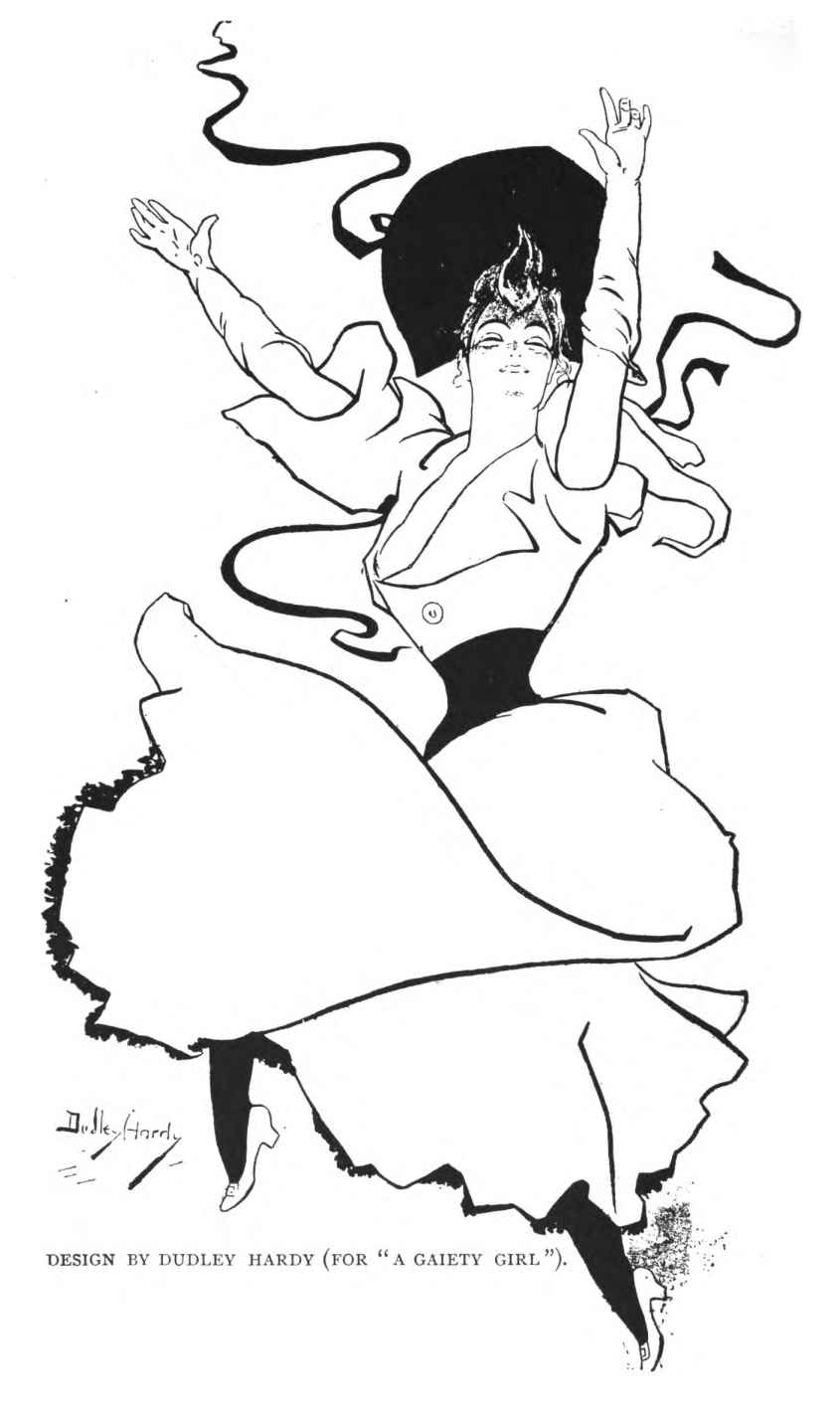
Original
or at least improbable, if France had not paved the way, is scarcely to discount their immediate and unequivocal success: even the greatest artist is unwise if he does not condescend to make use of the work of the past.
It is, I think, Mr. Dudley Hardy who, of the three artists named, owes most to France. He has made a variation, a very personal and alluring variation, be it said, of a theme essentially Gallic in its unrestrained gaiety, its reckless joyousness. There is something of Chéret, and there is even more of Jan Van Beers, in the end-of-the-century girl, elegant as she is impudent, whom Mr. Hardy depiéts with such amazing verve and abandon. She is too light-hearted, too irresponsible, to be a daughter of this land of grey and rainy skies; she takes nothing seriously, save perchance a detail of her costume. And yet she is stamped with Mr. Hardy's personality as thoroughly as are the charming Parisiennes of Chéret with the individuality of their inventor. Mr. Hardy began, and began wisely, by trusting for his effect to a single bold figure. Elaborate composition implies detail, and detail is one of the pitfalls of the designer of posters. Take, for example, the vast sheets which were employed to advertise one of the spectacles at Olympia. The overcrowding of small figures and closely-realized views either produced no impression whatsoever on the spectator, or at the most an impression due entirely to the immensity of the sheets. Mr. Hardy's series of posters commenced most auspiciously with that audacious young lady in a yellow dress, saucy hat, and flying black boa, who, not deigning to entreat, compelled the passer-by to rush to the nearest bookstall for a copy of Mr. Jerome's weekly "To-Day." Later, in similar vein, came the dashing girl in red, used by the manager of the Prince of Wales's Theatre to insist on the merits of "A Gaiety Girl." It may be doubted whether any more effective mural advertisement has ever been seen in London than that formed by half-a-dozen copies of this poster, arranged in the manner of a frieze in front of the theatre during the run of the piece. If the idea was that of the bill-sticker, the man was a genius of his kind: I cannot help suspecting, however, that the striking arrangement was due to Mr. Hardy himself. Or perhaps it was the happy thought of an outsider. In addition to the large "Gaiety Girl" poster, the two smaller bills which this artist designed to advertise the same play, full as they were of dash and go, must not be overlooked. To the collector they have a merit which he will not fail to appreciate. They are of manageable size, and this is more than can be said of most of Mr. Hardy's productions. It must not be thought, however, that
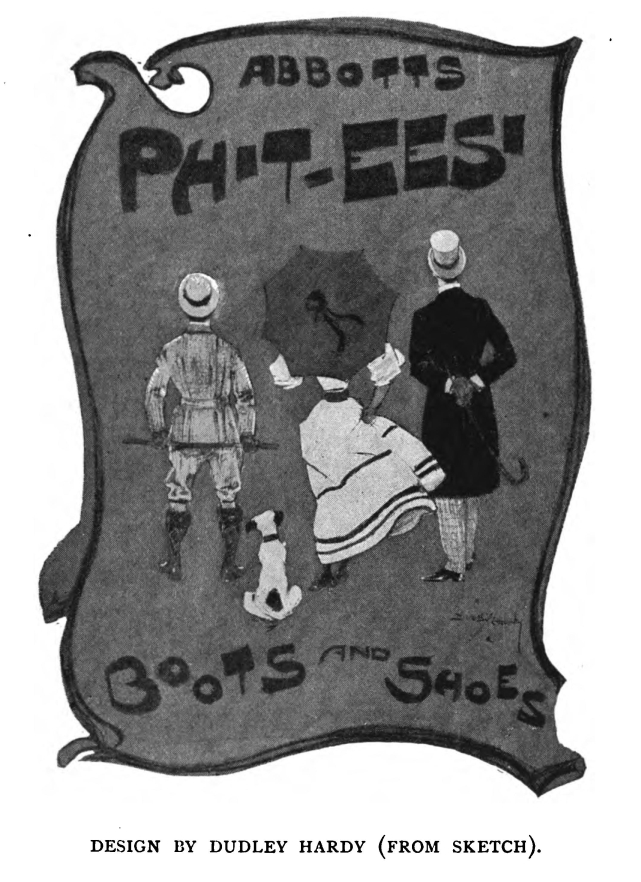
Original
Mr. Hardy can do no more than repeat with slight variety of detail the chic girl to whom he first introduced us; already, notwithstanding the comparatively small number of his designs, he has shown a very commendable versatility. The proprietors of "St. Paul's," in the days when that journal regaled its readers on the portraits, not of dancing girls, but of right reverend prelates, commissioned Mr. Hardy for a large design appropriate to the semi-ecclesiastical character of their journal. The choice, in view of the "Yellow Girl," was a somewhat curious one; but the experiment justified itself. The artist rose to the occasion; on the hoardings of London there appeared a woman of austere, even saintly, demeanour, clad in sombre robes, and armed with a spike of the Madonna lily. In spite of the low scheme of colour, the design was very telling as an advertisement. It has become very rare; indeed, notwithstanding the fad; that the dealers quote it at various prices in their catalogues, it may be questioned whether it is to be procured at all. When the policy of "St. Paul's" was changed—when it stepped down from its shrine to join the multitude and be of the world, worldly—the art of Mr. Hardy was once more called in to introduce the paper in its new guise. For the first time, so far as I know, he attempted composition. His idea was a happy one. The poster represented a young lady, evidently light-hearted and of unquestionably fantastic costume, see-sawing on a quarter of the moon with a gentleman of slight intellect, but exceedingly smart clothes. Seen under certain conditions the composition is distinctly effective, but from a long distance it fails to assert itself as do Mr. Hardy's simpler designs. In his most recent effort he has returned to the single figure, and he has done nothing more striking than his bill for "The Chieftain," at the Savoy Theatre, which represents a man in picturesque costume on a red ground. The lettering of nearly all Mr. Hardy's posters is admirable. It is invented by the artist himself, and forms an essential part of the design. For the rest, it should be remembered that the poster is a mere incident in Mr. Hardy's art career. As an illustrator he is with us everywhere; as a painter he is held in deserved esteem. It is to be hoped, for the sake of the artistic poster in England, that he will continue to devote some of his time to a branch of art in which, in comparatively a short time, he has so greatly succeeded.
The art of Mr. Aubrey Beardsley has been so enthusiastically received, on the one hand, as a new revelation, and so passionately condemned, on the other, as the mere glorification of a hideous and putrescent aspect of modern life, that it is difficult to consider his work with calmness. One thing, however, is certain: an impression

Original
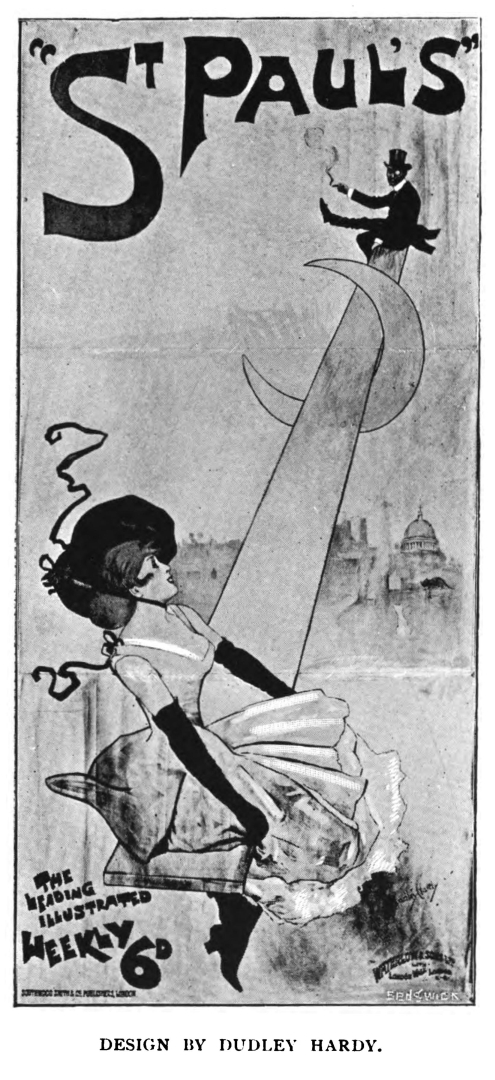
Original
of some kind, whether agreeable or the reverse, it has undoubtedly left upon all who have seen it. It cannot be dismissed by stating that it is derivative rather than original; that to a large extent it is the outcome of Japan, and in a less degree of the old English school of caricaturists. Whether it be good or bad, the extraordinary impression it has made cannot be gainsaid. It is probable that the work of no young designer of recent times has called forth so much homage of imitation, so great an amount of that kind of caricature which is among the sincerest forms of flattery. Mr. Beardsley's eccentricities are so pronounced, that to parody his work was simply to do the obvious. From "Punch," august by reason of its fifty years of tradition, to the poorest comic rag produced to catch the errand-boy's spare halfpenny, is a far cry; and yet the former, no less than the latter, has treated its readers to a series of pictorial Beardsleyisms. It would have been wonderful, indeed, if Mr. Beardsley, who is nothing if not modern, had not attempted the artistic poster. His opportunity came when the Avenue Theatre was taken by an enthusiastic and courageous young actress for the production of plays by living English writers, which, whatever their fate from the commercial point of view, were at least to possess definite merits as pieces of literature. In order to advertise Dr. Todhunter's "Comedy of Sighs," and Mr. G. Bernard Shaw's "Arms and the Man," Mr. Beardsley excelled himself, and designed perhaps the most remarkable poster ever seen, up to that time, in London.
Nothing so compelling, so irresistible, had ever been posted on the hoardings of the metropolis before. Some gazed at it with awe, as if it were the final achievement of modern art; others jeered at it as a palpable piece of buffoonery: everybody, however, from the labourer hurrying in the dim light of the morning to his work, to the prosperous stockbroker on his way to the "House," was forced to stop and look at it. Hence, it fulfilled its primary purpose to admiration; it was a most excellent advertisement. The old theatrical poster represented, in glaring colours, the hero in a supreme moment of exaltation, or the heroine in the depths of despair. Mr. Beardsley did not condescend to illustrate, but produced a design, irrelevant and tantalizing to the average man, though doubtless full of significance to himself. In many respects the Avenue bill must be considered the best poster which so far has come from this artist's hands. The very graceful figure on a small poster for "The Yellow Book" speaks for itself. It is more vivid, more curious, than either of the two done for a London publisher. Most collectors, however, will treasure even more highly

Original

Original
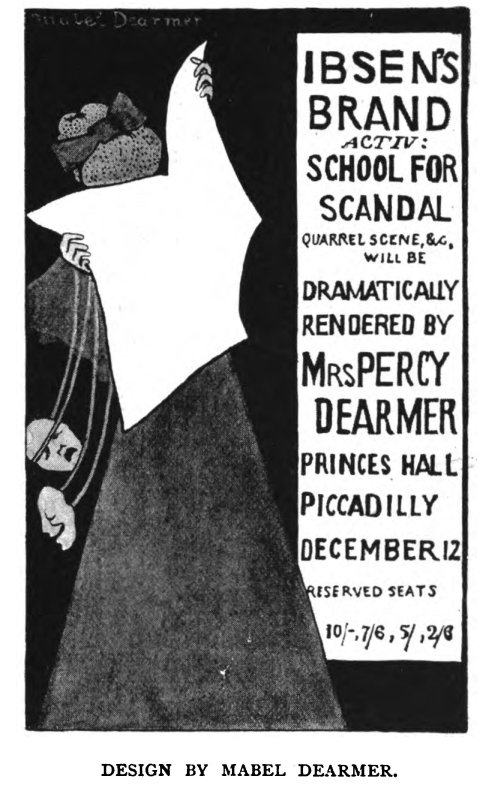
Original
the charming design done by Mr. Beardsley to advertise the Pseudonym series of short stories. In it we meet with the artist in his less mordant mood. The sketch of the old bookshop in the background is quite delightful, and the whole design is less grotesque than most of Mr. Beardsley's productions. The arrangement in purple and white, which he did for the same firm, is a very striking performance in his later manner. Its importance as a poster is, however, seriously discounted by the fact that the design has nothing whatsoever to do with the text, which has been added in a manner almost inconceivably clumsy.
The success of Mr. Beardsley in the production of artistic posters has encouraged a host of imitators, so that it is quite within the bounds of possibility that he will found something in the nature of a school. Already, on the other side of the Atlantic, more than one artist has been inspired by him. The posters of Mr. Bradley, for example, with which I shall deal later, are unquestionably adaptations, at once skilful and intelligent, of Mr. Beardsley's decorative manner. Again, to return to England, the pleasant arrangement in red and white, designed by Mrs. Dearmer to advertise a recital recently given by her in London, proves that she has been affected by the simplicity and directness which are so conspicuous among the merits of Mr. Beardsley in his essays in the art of the hoarding. Of his many parodists only one, I think, has actually attempted the poster. The essay in question was made by Mr. J. Hearn, under the signature of "Weirdsly Daubery," and the result was very fantastic and amusing. The design was done for some amateur theatricals at Oxford, and it was curious to

Original

Original
meet this atom of the so-called decadence flaunting itself, with strange incongruity, in every nook and corner of "the sweet city of the dreaming spires."
The case of Mr. Maurice Grieffenhagen is similar to that of Mr. Dudley Hardy, insomuch as both have been well known for some time to the public as painters and as the producers of very accomplished work in black and white. At present Mr. Grieffenhagen, as a designer of posters, can only be judged by a single production. It may be said at once that nothing more distinguished, nothing which is less imitative or derivative, has come from English hands than Mr. Grieffenhagen's advertisement for the "Pall Mall Budget." Admirable alike in colour and in pattern, the poster is entirely appropriate to its purpose of keeping before the eyes of the public a publication which escaped frivolity on the one hand and dulness on the other. All who watch the development of the artistic poster in England with interest, cannot but hope that the "Pall Mall Budget" poster will be the first of a series by the same artist equally delightful and original.
It is interesting to note that while we are still a long way behind the French in the matter of the artistic poster, the productions of the three artists with whom I have just dealt have received a cordial welcome at the hands of Parisian collectors. In the dealers' shops you may see Mr. Hardy's "Gaiety Girl" side by side with Lautrec's "Reine de Joie," while Mr. Grieffenhagen's young lady in red looks with demure surprise at the antics of her more frivolous sisters, as depicted by Jules Chéret. There is, again, a steady demand for anything by Mr. Beardsley, who, it would seem, has already become an established favourite with French connoisseurs. As we shall see in another chapter, the prices put in Paris upon English posters compare very favourably with those at which the works of the ablest French designers are valued. In matters of art, few cities are more insular and intolerant than the French metropolis; and those English artists who are devoting themselves to the poster, should be encouraged by enthusiastic recognition where enthusiasm was least to be expected.
CHAPTER VIII.—THE WORK OF OTHER CONTEMPORARY ENGLISH DESIGNERS
Since this book was commenced as the companion, rather than the rival, of that of M. Maindron, English designers of the poster have multiplied in a degree altogether phenomenal.
Up to the time in question, as we have already seen, the English artist who attempted the poster was exceptional. The famine, which was prevalent only a year or two ago, has become the abundance of today, so that where one expected a dearth of subject matter, one has in fact an excess. It seems to me that, apart from the English pioneers, whom we have already considered, the brothers Beggarstaff, in reality Messrs. Pryde and Simpson, two young artists, are entitled to the first place among the makers of the English artistic poster. They have best appreciated the essence of their business: less than almost any native designers, they are innocent of any homage of imitation. They have imitated neither Chéret nor Lautrec: it may well be that they have had the wisdom to take a hint here and there from both of these masters of the art of the affiche. As yet the hoardings of London are screaming with the vulgar designs of the advertiser's hack. The admirable art of the Beggarstaffs is, up to now, infrequently met with. Their curious advertisement for Sir Henry Irving's production of "Becket," was eclipsed by that done for the same manager's "Don Quixote," while the latter has to give place to one intended to announce a special issue of "Harper's Magazine." All of these force themselves on the collector's attention. They are at once striking and artistic; they cry their wares well, and they are a delight to the eyes. The lettering in the Harper poster is beyond all praise. Of its kind, it is the most beautiful English lettering of which I know. At the Aquarium Exhibition the Beggarstaff's showed four posters which advertised Nobody's Blue, Nobody's Candles, Nobody's Niggers, and Nobody's Pianos. If each "Nobody" is not rapidly converted into "Somebody," the various manufacturers and proprietors of the articles mentioned above must be very stupid people. All were excellent; that which advertised Nobody's Pianos was a most curious and à most original performance. It seems to me that the Beggarstaffs have few serious rivals in England, and not very many in France. Their works should help very
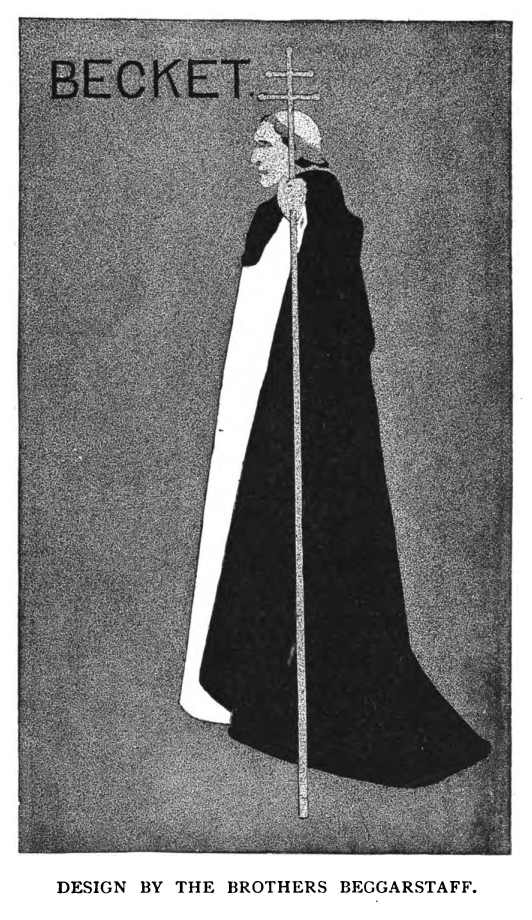
Original
considerably in the task of revolutionizing the English pictorial poster. The

Original
impression created by their designs on Frenchmen, who are past masters in the art of the hoarding, is most favourable.
It will be remembered that when Mr. Sickert took it into his head to depict the Sisters Lloyd in their music-hall habit, the critics fell out greatly. Even the young ladies in question had, it is said, scant affection for a design in which everything was suggested and nothing declared.
They had, it is true, the recompense of advertisement, and that, to a music-hall singer, is a very sweet recompense. It was characteristic of Mr. Sickert that he should go to the music-halls for a subject. The "New English Art Club" is devoted to things which are

Original
new and strange, the artistic poster amongst them. Mr. Sickert is not the only one of the members of this club who have made an essay in the latest form of applied art. Mr. Beardsley, Mr. R. Anning Bell, and Mr.

Original
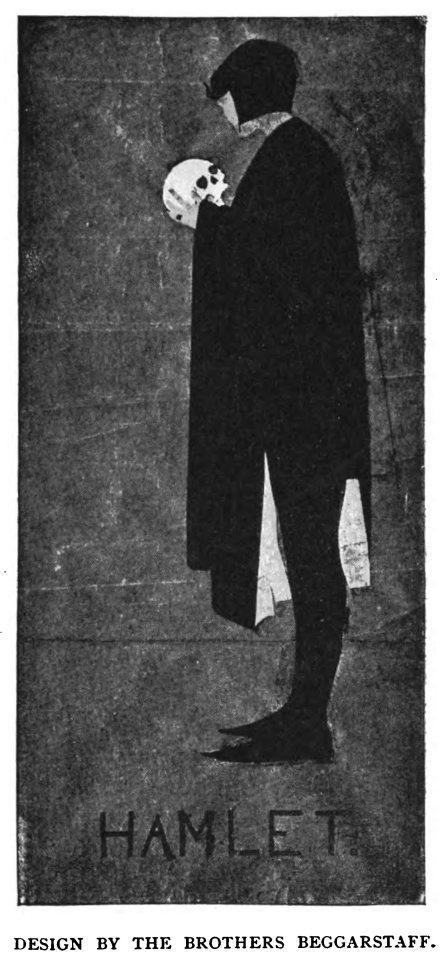
Original

Original
Wilson Steer are amongst those of his colleagues who have done the same thing. Mr. Sickert's poster, which is, I believe, as yet unpublished, is in four colours. It is calculated to make a good advertisement, and one can only hope soon to meet with it on the hoardings. As an impressionist painter of talent, Mr. Wilson Steer is as well known as Mr. Sickert. A "New English Art Club" Exhibition without his work would be one which lacked a most characteristic feature. Mr. Steer gave us an opportunity of appreciating his talent as a painter by organizing a show of his own work. To advertise this he did a poster, which was excellent of its kind, and is in consequence very rare. It is a comparatively small lithograph in four colours, and is quite unlike this artist's other work. It leans, it seems to me, towards Pre-Raphaelitism rather than towards Impressionism. An artist who has certainly sat at the feet of Mr. Whistler is Mr. Mortimer Menpes. To advertise several exhibitions of his paintings, he has invented at least three posters, which certainly do not lack the merit of originality. He has abstained from the frivolous girl and grotesque man. The "France," the "Venice," and the "India" are in their way considerable achievements in dainty design and quiet and harmonious colour. Mr. Menpes, by being intentionally simple, has arrived at notable conspicuity. All this artist's designs are of small size, and are appropriate rather to the notice board than to the hoarding. Nothing more opposite to the fastidious productions of Mr. Menpes could be conceived than the vigorous poster by Mr. Lockhart Bogle advertising a Scottish Athletic Gathering, held in 1892. This is a large lithograph, consisting of a single figure of a Highlander, which, if not remarkably beautiful, is drawn with vigour and with no small accuracy. Mr. Brangwyn is one of those English painters of whom we are entitled to be proud. His directness, the audacity of his impressionism, the splendour (if sometimes ill-considered) of his colour schemes, cannot be passed over even by those who have slight sympathy with his method. That, if so inclined, he would produce a poster at once startling and artistic is not to be denied. The one which he has already designed to advertise an exhibition of South African pictures by himself and Mr. William Hunt, held at the Japanese Gallery, is certainly by no means worthy his remarkable talent, and one trusts that he will cease for a moment from painting pictures and produce a poster which shall be memorable in the history of the affiche in England.
Mr. Frank Richards is nothing if not versatile; his exhibition, held recently at the Dowdeswells' Galleries, came as a surprise to all who were unacquainted with his

Original
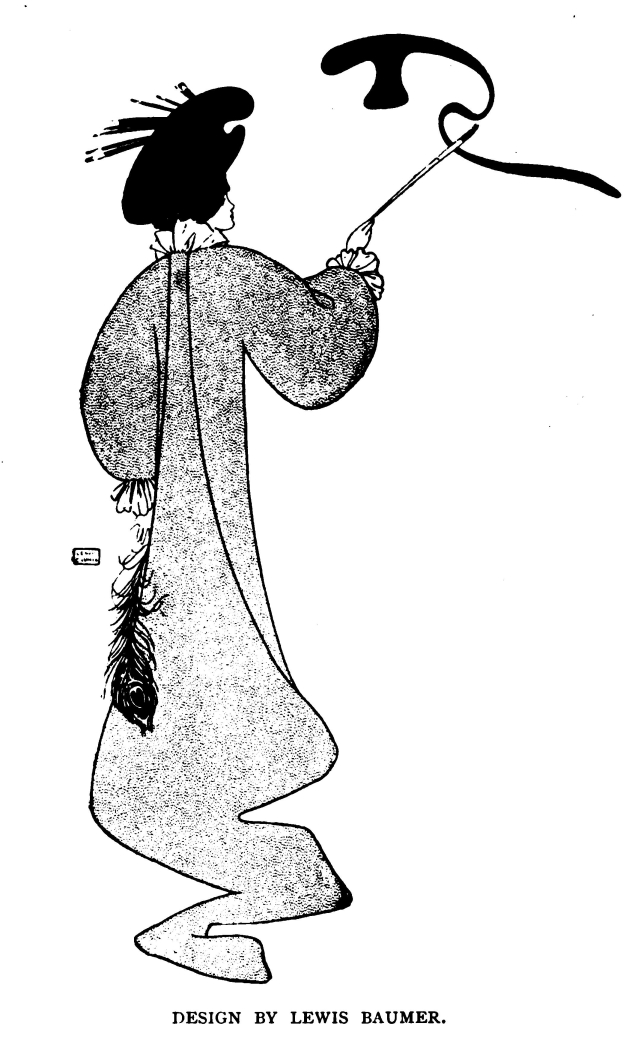
Original
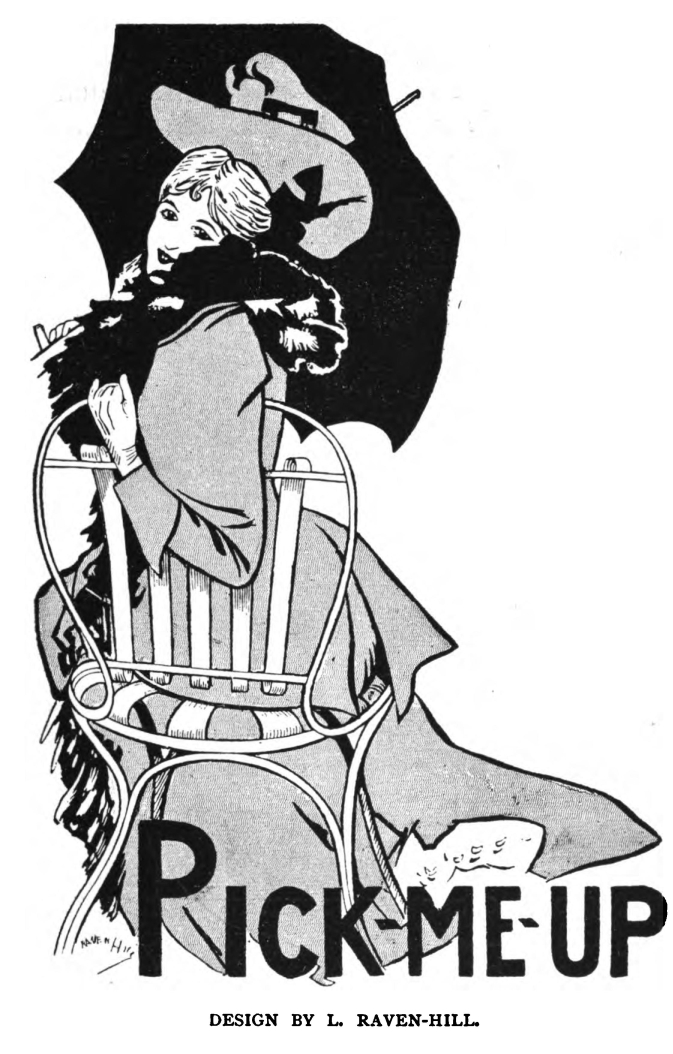
Original
clever painting. In this exhibition his pictures ranged from a large study of Mr. Clive as "Hamlet" to slight but beautiful studies of Venice under various atmospheric conditions. In his poster work, of which at present little has been seen, Mr. Richards shows that, to some extent, he is under the influence of Mr. Dudley Hardy. Mr. Richards, no less than Mr. Hardy, is undeniably up to date, and his work is really effective. Among the most recent additions to the ranks of our popular illustrators is Mr. Lewis Baumer. One meets with his work everywhere; in "To-Day" and in the shortlived "Unicorn." His bills to advertise the Academy students' annual burlesque are pretty, if they are nothing else. Mr. Baumer has certainly still to make his mark as a poster designer. The Artistic Supply Company, who are paying special attention to the pictorial poster, have already produced a dainty little affiche by him. It may be noted here that the company in question have arranged with some of the most eminent English designers for the reproduction of artistic posters, and that several, which illustrate these pages, do so only on account of their permission most generously given.
Among other services which the comic journal "Pick-Me-Up" has rendered to the artistic public is the extremely important one of emphasizing, and giving a congenial outlet to, the remarkable talent of Mr.

Original

Original
Raven-Hill. From almost the first, his connexion with the journal in question has been a very intimate one. Hardly a number is without a specimen of his powerful drawing and his gift of comic invention. While suggesting, in the best sense, the style of the incomparable Charles Keene, Mr. Raven-Hill's work in black and white is the outcome of his own personality. It would have been strange if this very modern artist had not produced pictorial posters: his talent was perfectly adapted to his doing so with success. His small bills for "Pick-Me-Up" are vigorous in drawing, bold in colour, and of a pleasant fantasy. They only measure twenty by thirty inches, but they are very telling. A complete set of them is a most desirable addition to the collector's portfolio. Another accomplished member of the staff of "Pick-Me-Up," Mr. Edgar Wilson, has designed a bill for the recently defunct journal, "The Unicorn." It is effective, but to me personally, the colour scheme is even more crude than the exigencies of a poster demand. Mr. Reginald Cleaver, whose sketches of scenes in the House of Commons created so favourable an impression in "The Daily Graphic," has not yet, I believe, deliberately produced a pictorial poster; but one of his drawings, reproduced on a large scale, lends itself well enough to the purposes of mural advertisement. Mr. Sydney Adamson, the art editor of
"To-day" and "The Idler," has done a bill which, when it is seen, will be Jield, I have small doubt, a very striking performance. It is happily conceived and boldly executed, and should make a striking patch of colour on the hoardings.
Merely to chronicle the names of the innumerable Wilsons who are producing pictures would take quite a considerable space. It may be noted in passing that, like Edgar of that name, Mr. W. Wilson has also attempted an affiche.
Among others who have designed posters which have yet to be seen an the hoardings are Mr. Max Cowper, Mr. A. R. Miller, Mr. Kerr Lawson, Mr. F. H. Townsend, whose black and white work one meets everywhere, Mr. Roche, a prominent member of the Glasgow School, and one of the greatest living English artists, Mr. Phil May.
Mr. Phil May is not the only "Punch" man who has been seized with the prevailing mania for the production of posters. His colleague, Mr. Bernard Partridge, has already designed one which is reproduced in these pages. One associates Mr. Partridge with dainty and idyllic work rather than with work which is vigorous, but his first essay in the poster seems to me to be very promising. Mr. J. T. Manuel's work is as unlike that of Mr. Bernard Partridge as possible. His pictures might be by a clever member of the young French School who

Original

Original

Original

Original

Original

Original

Original

Original

Original
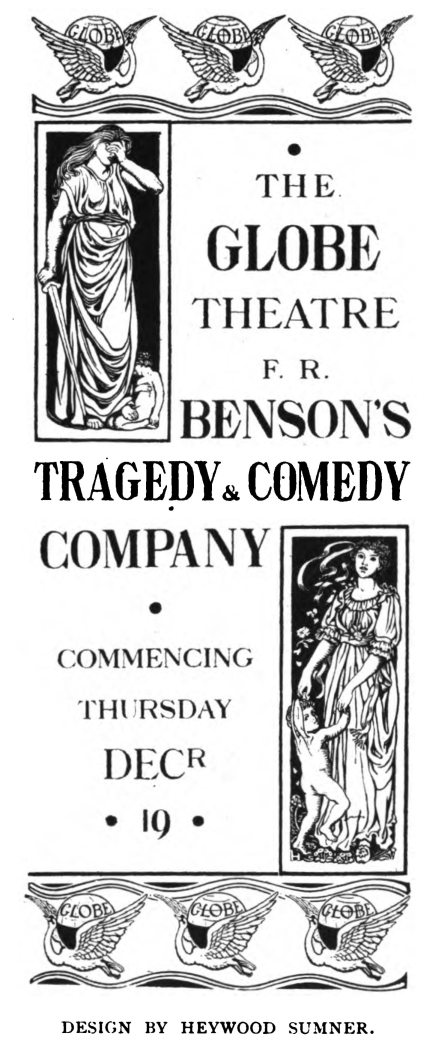
Original

Original
have taken more than a hint from Forain. The designs for posters which Mr. Manuel exhibited at the Westminster Aquarium, if not so distinctive of his talent as his contributions in black and white to "Pick-Me-Up," were not without definite merit. Of the three, that catalogued as "A Music-hall Singer" struck me as the best. It should be purchased by Miss Minnie Cunningham, for the likeness between her, and the young lady it represents, if accidental, is marvellous. Among young decorative painters of the day who are not mere imitators of such masters as Sir Edward Burne-Jones or Puvis de Chavannes, but have invented a style for themselves, must be included Mr. Charles Ffoulkes. The two examples of his poster-work here reproduced are as beautiful in colour as they are refined in pattern. Moreover, they proclaim themselves in loud tones. Their tones, however, are those of a silver trumpet rather than those of cymbal or of gong. At times Mr. Ffoulkes forsakes his lofty imaginings and depicts chic young ladies quite in the best French manner. Mr. L. Solon's poster, reproduced here, is a very characteristic example of his decorative style. In inventing it, the artist has clearly kept before him the fact that a poster cannot live by beauty alone; if, happily, there be beauty, there must of necessity be advertisement, else is failure inevitable.

Original
Very unlike Mr. Solon's poster are the affiches of Mr. Heywood Sumner; those which I reproduce here seem to me to be very characteristic of his graceful gift of design. Mr. Morrow is already an established favourite on the hoardings of London, and justly so in that his performances are of exceptional merit. His "Illustrated Bits"

Original
is a radiant affair, and his "New Woman" makes quite a pretty picture. His works should certainly be collected.
Of Mr. R. Anning Bell it is not too much to say that for versatility only Mr. Walter Crane among English artists can be said to rival him, and, what is far more important, his success in a medley of mediums is not to be gainsaid. His poster for the Liverpool School of Art, over which he presides, is a magnificent piece of decoration, and nothing so fine, in its way, has ever been, seen on English hoardings. It takes one up to the Elgin marbles; it is an oasis of the classical in a desert of the new. I can only mention the following native artists, not previously considered, who have produced pictorial posters of interest: Mr. F. Barnard ("Everybody should read in the European School"), Mr. F. Simpson ("Land of the Midnight Sun," "To Norway Fjords"), Mr. Robert Fowler, R.I., whose poster for the Walker Art Gallery is here illustrated, Mr. Sidney Haward (p. 279), Mr. Skipworth ("An Artist's Model"), Mr. Skinner ("Pall Mall Magazine"), Mr. Starr Wood and Mr. A. G. Draper.
I have already remarked that the poster movement in this country amounts to a positive revolution. No young artist is satisfied unless he has a hand in the decoration of the hoardings; the gold frame is for the time forgotten, and all have their eyes on the lithographer's stone. France has undoubtedly had a long start of us, but if she is to retain her supremacy she must look to her laurels. Our young men are beating at her doors, though beating only in a spirit of friendly rivalry. Happily, between England and France there is, at this moment, only one war-the war of the pictorial poster.

Original

Original
CHAPTER IX.—IN AMERICA
In the sweet uses of advertisement the American is surely an expert, and it would have been curious indeed, if he had overlooked so obvious and so effective a method of advertising as the pictorial poster. Finding, in the notorious phrase of Mr. Whistler, that "Art was on the town," the American advertiser was one of the most eager of those passing gallants who chucked her under the chin. Who it was originated the artistic poster movement in the States, it were hard to say with certainty: it may have been Mr. Matt. Morgan. Among recent American poster producers, three, however, are most conspicuous, Mr. Edward Penfield, Mr. Louis J. Rhead, and Mr. Will. H. Bradley. It is probable that the first-named was the innovator: at least, one would be tempted to judge so from the quantity of his designs.
Mr. Penfield is still young, having been born at Brooklyn in the year 1866, so that if he was the first American artist to deal with the poster, the movement in that continent is obviously a recent one. Most of his posters are on a small scale, and partake of the nature of window-bills rather than of placards especially destined to the hoarding. At the same time, Mr. Penfield has been by no means slow to appreciate that it is the first

Original
business of an advertisement to advertise, and his appreciation of this fad, coupled with a very dainty fancy and no small technical skill, has led to results which are of unquestionable importance. With his earliest efforts I cannot pretend to be well acquainted. In 1893 he produced for a firm at Salem a large bill which measures eighty-one by forty-two inches. The subject is a girl in a black dress and yellow jacket who is laden with packages. For the publications of the firm of Harpers, Mr. Penfield has done quite a quantity of excellent and artistic advertisements. Amongst the most effective is one produced for a special midsummer number of "Harper's Bazar," representing a girl playing a banjo, divided by a crimson sun from an attentive listener of the opposite sex. Again, for the issue of July, 1894, the artist gives us a girl in white lighting red crackers arranged to spell the name of the month. For the February number of the following year, we are presented, most appropriately, with a gentleman posting a valentine in an orange coloured letter-box. In April of the same year, Mr. Penfield gives us Joan of Arc in yellow, wielding sword and staff. Amongst the numerous books which Mr. Penfield has advertised may be mentioned "The Cloister and the Hearth," "Pastime Stories," "Our English Cousins," and "Perlycross." This artist's work is always ingeniously conceived, and the colour schemes are not seldom pleasantly audacious. Mr. Penfield gives us very agreeable versions of the American girl in general, and of the "summer girl" in particular. His maidens are adorably conscious of their power to charm, and are fully alive to the fact that their gowns are of the smartest.
To turn from Mr. Penfield to Mr. Louis J. Rhead is to turn to an artist settled in the United States, but English by birth and education. Mr. Rhead was born at Etruria, that unclassical place with the classical name, and comes of a family of artists. He was, I believe, a student at South

Original

Original
Kensington for several years, and only reached America in 1883. He has exhibited at the

Original
Salon and the Academy and other important picture shows.
Mr. Rhead seems to have taken to the poster with the greatest enthusiasm, and he has undoubtedly produced a series of curious and striking designs. By far the most important of his efforts, though not the largest, are the designs which he has done for the New York "Sun." In one of these very daring productions, a crimson sun glows in a golden sky. The ground is green, the footpath and the trees are blue, while the girl's costume is garnet and red. It must be confessed that this colour scheme sounds somewhat formidable, but Mr. Rhead has invented an arrangement at once artistic and compelling. The lettering, it must be noted with regret, is not from his own hand. One of the largest of Mr. Rhead's posters is the "Pearline," in which a girl in a green and red dress is represented in the act of pinning a sheet on to a line. This design measures forty-one by twenty-eight inches. Of considerable size, and of no small merit, is the poster executed for the "Century," Christmas, 1894, the chief feature of which is a girl with a peacock. Among other effective designs which stand to the credit of Mr. Rhead may be mentioned those advertising "Harper's Bazar," Christmas, 1890, Thanksgiving, 1894, and Christmas of the same year. For the "Century," besides that already noticed, he has done several interesting posters, and he helped to advertise various numbers of "St. Nicholas" last year. It is to be noted that

Original
Mr. Louis Rhead has held an exhibition of his posters, the catalogue of which, by reason of its very characteristic and personal decorations, is highly esteemed by collectors of those unconsidered trifles which end in becoming especially dear to the connoisseur.
Among the magazines of the world, the "Chap Book," which emanates from Chicago, is by no means the least interesting. Fascinating as is the title, the contents of this little periodical are still more so; its editors seem to have eschewed banality, and to have gone in for novelty, even when the new did not possess an extraordinary degree of merit. It were meet that so original a publication should have an advertiser of corresponding eccentricity. In Mr. Will. H. Bradley, the proprietors of the "Chap Book" undoubtedly possess such an one. Born at Springfield, Massachusetts, Mr. Bradley lives in Chicago, and to that town and its publications he has mainly devoted his energies as an artist advertiser. It will hardly be disputed that he has seen and assimilated, in no small degree, the manner of Mr. Aubrey Beardsley. He is, however, a great deal more than a mere imitator; what he has borrowed, he has borrowed with conspicuous intelligence, and nobody could for a moment accuse him of anything approaching petty larceny. Among his most important posters is a colossal one which, in the manner of Mr. Beardsley, proclaims the attractions of the drama by Mr. Henry Arthur Jones, entitled "The Masqueraders." In 1894 Mr. Bradley advertised the "Chap Book" by means of two dancers in red and brown costumes; the following year he insisted on the same publication by means of a girl in white and a man in black; and yet again, through the medium of a young lady in blue, mixed up with trees in intense purple, outlined with red and white; and several other equally effective compositions.
Mr. Bradley is, however, not the only artist intimately connected with Chicago who has distinguished himself in the production of posters. A native of that city, Mr. Will. Carqueville, has done very interesting work for the firm of Lippincott's. In the year 1894, at least one design by him was commissioned, and in the succeeding year he produced four or more. That he is not afraid of colour is proved by the fact that in the poster done for Lippincott's, March, 1895, he combines dark purple, yellow, blue, and bronze. In another design we meet with red, purple, yellow, and blue. Mr. Kenyon Cox is an American artist whose fame is by no means confined to the United States. A pupil of Gerôme and Carolus Duran, he has, so far as I know, made only one essay in the art of the poster. This measures eighty-one by forty inches, and is in black and white. It represents a male figure carrying a torch, and is an advertisement for "Scribner's Magazine." Mr. Scotson Clark was a schoolfellow of Mr. Aubrey Beardsley. He has, among other posters, done two to which the picturesque labels of "Our Lady of the Peacock Feather," and "Lady of the Iris," are attached. In addition, for the March issue of the "Bookman," 1895, Mr. Scotson Clark drew a monk, with book in hand. Mr. George Wharton Edwards, the well-known painter in water-colours, must be credited with three designs for the "Century," in the months of February, March, and April, 1895. Moreover, by means of a drawing of a girl and a peacock, he proclaimed the twenty-eighth annual exhibition of the American Water-Colour Society, in addition to designing a bill for a book entitled "The Man Who Married the Moon." The advertising enterprise of the firm of Scribner has made poster-collectors the richer by one or two productions by Mr. Charles Gibson Dana. He it was who announced, with no inconsiderable skill, the issues of "Scribner's Magazine" for the months of January and February, 1895. Mr. Archie Gunn is the son of a well-known drawing master in one of the large towns of the Midlands. Leaving England for America, he found an outlet for his talent as a draughtsman on the New York journal "Truth." His work is nearly always vivacious, even where it is not particularly original. His posters were done for the "Illustrated American," and are by no means bad examples of his craftsmanship. Like most prominent American artists, Mr. Thomas Burford Meteyard studied in Paris. His poster to advertise a book called

Original

Original

Original

Original

Original

Original

Original
"Songs from Vagabondia" is in black and white, and consists of portraits of the artist himself and the authors of the book, Mr. Bliss Carman and Mr. Richard Hovey. A limited number of copies were printed "sur Japon," and these, I believe, are rare. As in the case of so many other American artists, Mr. Francis Day's poster work was done for the most part for the great illustrated magazines which do such credit to the United States, as an art-producing nation. Mr. Day's design for "St. Nicholas," Christmas, 1894, seems to me altogether agreeable, while in the series designed for "Scribner's Magazine," more than one interesting thing will be found.
In dealing with the poster in England, we have noticed the fact that one woman, Mrs. Dearmer, has succeeded in producing a bill at once artistic and effective. Miss Ethel Reed would seem to be the most conspicuous lady-artist who has taken up the designing of artistic posters in the States. Her efforts date only from last February, when she did an advertisement for the "Boston Sunday Herald." Since then she has produced several designs which are held in considerable esteem by American collectors. Amongst other artists who have taken part in the poster movement on the other side of the Atlantic are the following: Messrs. Alder ("New York World," March 17th, 1895), Allen, Palmer Cox ("New Brownie Book"), C. Miles Gardner ("Boston Sunday Herald," February 10th, 1895, and March 10th, 1895), Oliver Herford, Charles M. Howard ("Boston Sunday Herald," April 21st, 1895), Frank King ("New York World," April 7th, 1895), H. McCarter (the Green Tree Library), Moores ("St. Nicholas," November, 1894), Julius A. Schweinfurth (Boston Festival Orchestra, 1895), W. Granville Smith ("Scribner's Magazine," Christmas, 1894), W. L. Taylor, Abby E. Underwood, R. Wills Irving, C. H. Woodbury, Charles Hubbard Wright, and William M. Paxton. The last named has been chiefly associated with the "Boston Sunday Herald," and for that journal he has produced several posters of distinction.
My review of the artistic poster movement in America has been of necessity brief, and cannot, therefore, be free from sins of omission. In writing it, I have, where my own knowledge has seemed to me insufficient, made use of the descriptive catalogue of the collection of American posters published last May by Mr. Charles Knowles Bolton, of Brookline, Massachusetts. From the useful bibliography printed at the end of this pamphlet, it would seem that the movement has been watched from the first by the American press with keen interest. So far back as the year 1892, we find Mr. Brander Matthews discussing the pictorial poster in the "Century" magazine. In the

Original
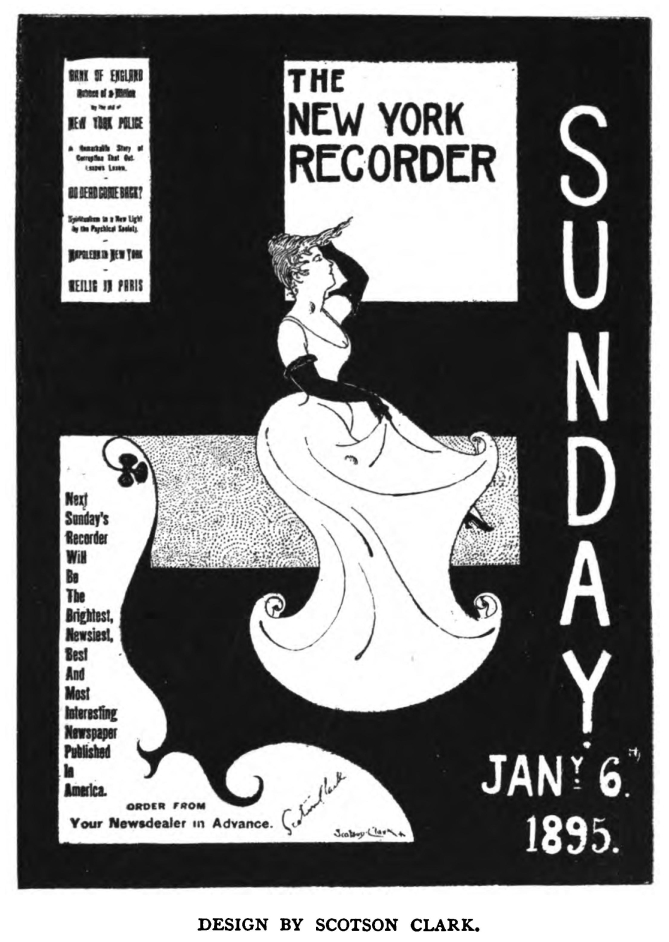
Original
present year the subject has been dealt with by writers in such important newspapers as the "New York Tribune" and the "Boston Herald," to say nothing of such journals as "Scribner's Magazine," the "Critic," the "Art Interchange," and the "Art Amateur." Quite recently the English public have had opportunities of seeing the best work by French and native artists. It is to be hoped that at the next poster exhibition they will be afforded a chance of seeing what excellent work American designers are doing in this very practical branch of applied art.
A poster by Mr. E. A. Abbey, illustrated on page 315, arrived too late for consideration in its proper place. It is entirely worthy the great reputation of the artist who has so kindly permitted us to reproduce it here. The figure is in red scale armour, bearing a shield with a red cross.

Original

Original
CHAPTER X.—IN COUNTRIES NOT ALREADY DISCUSSED
That the picture poster was an incident of the ancient civilizations of China and Japan; goes without saying. The scope, however, of this book does not embrace the Far East; the illustrated placard in the Orient would, indeed, be a subject in itself. In the matter of applied art it is difficult to conceive anything which the Chinese and the Japanese have not attempted. They seem, from the earliest days, to have been consumed with a passion for decoration; nothing which by any chance admitted of ornament was left undecorated. It behoves the societies which are formed for the purpose of illustrating the artistic antiquities of these wonderful countries to concern themselves with the dawn and history of the pictorial poster in the East. Certain it is that the illustrated advertisement abounded, as it abounds today, in the cities of both the nations now being discussed. It is, indeed, found in the less advanced civilization of Burma, and of the various principalities which form our Indian Empire. To pass from Asia to Spain is to travel a long way. In Spain, at the present moment, the illustrated placard is receiving no small attention at the hands of artists who, however discouraged and ill-paid, are determined to do all that in them lies to raise the country which produced Murillo to the position she once held among art-producing nations. A recent writer in the "Sketch" grows enthusiastic over the Spanish affiche. "Spanish posters," he tells us, "are a delight. Well drawn, vividly but truly coloured, and perfectly printed, they shine down from walls and hoardings, attracting all passers-by. They depict the glories of coming fairs and bull-fights, and are couched in terms calculated to draw money from a stone. The announcement that a famous matador will kill, or assist to kill, Seis Escogidos Toros, throws the Spanish reader into a state of frenzy. Not infrequently some incident is depicted with frank realism. A bull standing over a dead horse gives an opportunity to the artist to draw the unfortunate horse disembowelled and lying on blood-stained sand, while the bull's hide shows the marks of the lance-thrusts, and his horns are likewise stained with blood. Colour-printing is so good in these regions of perpetual sunlight that nearly every detail of a matador's costume can be given. The poster artists are splendid when they depict

Original
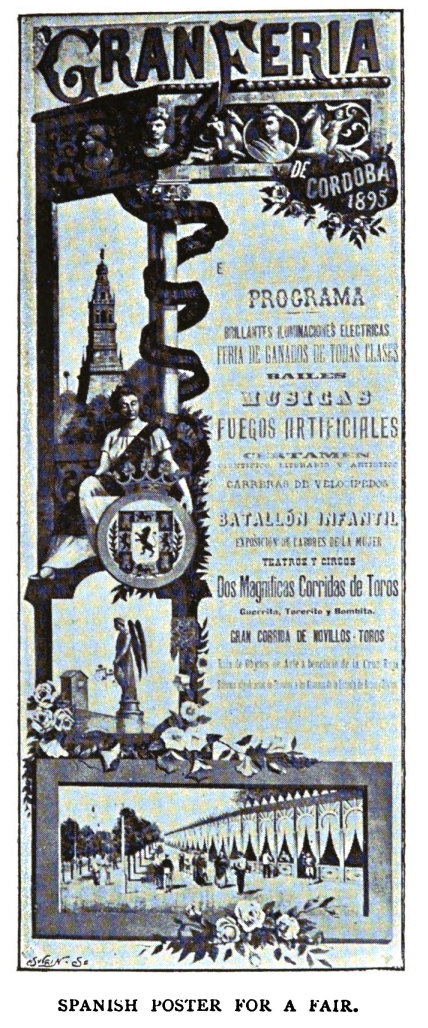
Original
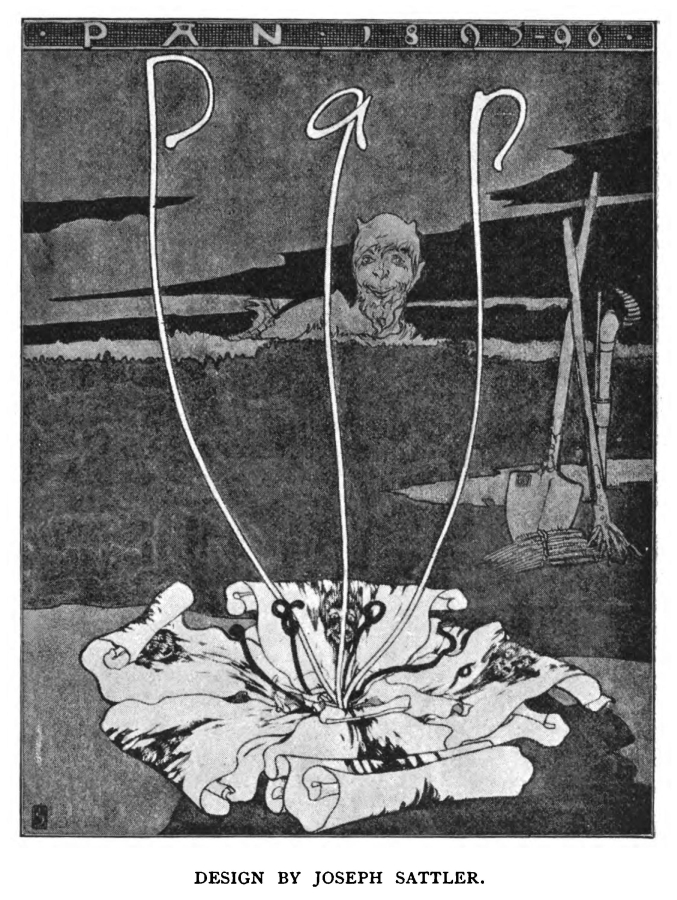
Original
movement; they are satisfactory in their purely decorative work, but figures in repose are apt to become 'woodeny.' In point of colour, Spain beats France; and as France is so much in advance of England, it scarcely needs a Euclid to demonstrate that English posters cannot be compared to those of Spain. The latter exhibit at times an admirable sense of distance and proportion, which serves to show that their designers learnt to draw before they began to paint." The four examples reproduced here will serve to indicate the type of Spanish poster most frequently met with. Whether Spain, in the matter of the pictorial placard, is in advance of France or not, is a question of taste. However brilliant the colour of the Spanish affiche, the design seems to me to lack boldness. Take, for example, the "Gran Feria de Cordoba, 1895;" in this case the whole thing appears to be a series of elaborate details rather than a bold and impressive design. The poster in Spain, however, is rapidly becoming of interest, dealing as it does with fascinating and essentially picturesque subjects. It is difficult to obtain exact information concerning the artists who design posters in Spain; the examples which I reproduce here, I cannot attribute to anybody with any degree of certainty.
The Teutonic temperament is in no sense akin to the Spanish, and the pictorial posters of Germany are utterly unlike those of Spain. For the most part the Germans have, in the past, been addicted to elaborate and often admirably-executed lithographs, such, for instance, as that done by Ernest Klint for the Musical and Theatrical Exhibition held at Vienna in 1892. A new movement is, it appears, making itself conspicuous just now. The younger generation of German designers seem to be as anxious to experiment in the making of posters as those of France and England. Joseph Sattler, a designer of considerable originality and great dexterity, who has studied Albrecht Dürer with great advantage to his own work, has designed a very curious little window bill to advertise "Pan." It is reproduced here, and its strange individuality, its ingenuity, will not fail to make an impression upon those who look at it closely. The lettering is devised in an extraordinary way, and Sattler may be congratulated on the results of an interesting experiment. Very different to the work of Sattler is that of Franz Stuck. This represents a classical head in mosaic, and advertises an exhibition of the Munich Secessionists, a body of experimental painters and designers of rapidly-growing importance. The tendency of the illustrated poster in Austria is much the same as it is in Germany. Some admirable bills have been designed in Italy. Of its particular kind, I have seen few things better than a large and

Original

Original

Original

Original

Original
sombre poster to advertise Verdi's "Otello." At the same time, the Italian posters are not of a very distinctive type, nor does Italian taste concerning them appear to be very fastidious. The crude, enormous, and vulgar advertisements for Buffalo Bill's exhibition created quite a sensation in Rome when that redoubtable personage deigned to visit the most august of European capitals. The modern Romans forgot their Michael Angelo in the ecstasy induced by the latest enormity of the American colour printer. It may be noted that some of the posters done for the Italian railway companies are bright and gay as an Italian summer itself. The pictorial poster would not seem to have taken a great hold on Russia, nor, judging from a comparatively recent visit, has it made much headway in Scandinavia. In Holland, the present artistic vitality and enterprise of which are at once so astonishing and gratifying, one meets with very few posters of conspicuous merit. In Belgium, on the other hand, there are signs that the poster movement has affected not a few artists of distinction. The placard by Evenepoel, designed to advertise a publication in connexion with the Antwerp Exhibition, is excellent in colour and pattern and most decidedly original, owing very little to any foreign examples. Duyck's "Cortège des Fleurs (Ville de Bruxelles)" is decorative and pleasing. This artist has also designed another placard to advertise Spa (Ferme de Frahinfaz). To Delville we owe a curious little placard, in the Symbolist manner, which advertised "Pour l'art, Ier exposition à Bruxelles;" the advertisement for the second exhibition was the work of Ottevaere. A fantastic and rather picturesque poster was done to announce one of the annual exhibitions of "La Libre Esthetique." It represents a strange-looking human being standing among flowers, under a lurid sky, and holding in his hands a decorative scroll, upon which the legend is inscribed. Amongst other interesting Belgian placards are the "Velodrome Bruxellois" by G. Gaudy, the "Paul Hankar" by A. Crespin, and a poster in monochrome in imitation of a bas-relief bearing the legend "La plus noble force sociale est le Droit." All of these are reproduced here. It may be noted in conclusion that most of the Belgian posters show strong signs of French influence.

Original

Original

Original
CHAPTER XI.—THE PRICE OF THE PICTORIAL POSTER; AND CONCLUDING NOTE
It is obviously impossible to state accurately the price of the artistic poster, insomuch as fluctuations take place almost daily, and, moreover, the numerous dealers vary in their quotations in an extraordinary degree. Under these circumstances, the present chapter is written as a matter of current record, rather than with the idea that it will be of any permanent value for purposes of reference. It may be stated at the outset, that in dealing with the value of the poster, rarity has in the first place to be taken into consideration; and thus it happens that, while delightfully artistic designs are comparatively inexpensive, posters which are quite unattractive from the point of view of art are often very costly. The prices which follow are for the most part taken from the catalogues of M. Edmond Sagot of Paris, and Mr. Bella of London, the latter of whom, by the organization of exhibitions and in other ways, has rendered material assistance to English collectors. In fact, to some extent, he has called the English collector into existence.
As an example of the price of the poster of which the interest is archaeological rather than artistic, one may instance a placard, dated the 20th of February, 1649, which deals with the opening and closing of the gates of Paris. Its only claim to be considered pictorial consists in the fact that it is ornamented with a woodcut representing the arms of the city. Many similar productions were executed in relation to London and to other English towns. The price asked for it three or four years ago was thirty francs. Interesting from another point of view are the illustrated posters which have heralded new books, or new editions of books, by great writers. Three of these, relating to the works of Balzac, and including one with woodcuts by Meissonier and Tony johannot, are valued at twelve francs.
It is time, however, to pass from pictorial posters, which are interesting on account of age or literary association, to those which derive their value from their qualities as works of art. In this class some of the highest prices are obtained by the French artists who, for the most part, were the contemporaries, or immediate successors, of Gavarni. The best posters of this master are extremely difficult to procure, and examples in a fine state realize large sums.
For the "Oeuvres Choisis" bill, together with that designed to advertise an illustrated edition of Balzac's "Philosophie de la Vie Conjugale," something over a hundred francs is asked, while less important works can be obtained for five-and-twenty or thirty francs. It goes without saying that the smallest tear or other injury, however neatly and skilfully repaired, heavily discounts the value of works by Gavarni and the men of his time; but even slightly damaged examples are eagerly sought for, as it is almost impossible to obtain perfect ones. Of the productions of Edouard de Beaumont, two of the rarest are the "Nains Célèbres," already mentioned, and the "Diable Amoureux." For an exceptionally fine proof of the former, as much as a hundred francs has been asked, while the latter, which is very rare, commands about sixty francs. Sums scarcely less formidable are given for the better posters of Grandville, and fifty francs for a good Tony Johannot is not by any means an exceptional price, although unimportant specimens of his work may be picked up in Paris for a few sous. The excursions of Gustave Doré into the art of the poster were very few. His most important work was perhaps the "Légende du Juif Errant," a fine proof of which realizes sixty francs or more. Posters by Vivant Beaucé, Castelli, Cham, Victor Coindre, Charles Devrits, H. Emy, A. Farcy, and others of the same period, for the most part command sums comparatively small; the best productions of Bertall, Calame, Monnier, and C. Nanteuil, on the other hand, are only a little less expensive than those of Gavarni and the more distinguished designers of his time.
Of posters by designers still living, those of Chéret have been most assiduously collected. It is probable that a complete set of his works does not exist; even one which is fairly representative, and includes some of his earlier and rarer affiches, is extremely valuable. In the Sagot catalogue of 1891, over five hundred and fifty posters by Chéret are described, and of these no less than eighty are priced at twenty francs or more. Since the publication of the catalogue, their value has steadily increased, and it is uncertain if many of them can now be procured at all. The collector of modest means need not, however, regret that the older and rarer examples of Chéret are beyond his reach, for the artist's more recent posters are the best that he has accomplished. For a comparatively small outlay, one may secure the flower of Chéret's work. Amongst the most valuable of his posters are two, of very large size, designed to advertise some Arabs who appeared with the Paris Hippodrome when it visited London in 1887. The price asked for them is over two pounds. They seem to have escaped the attention of French collectors from the fact that they were posted exclusively in London. The set of four
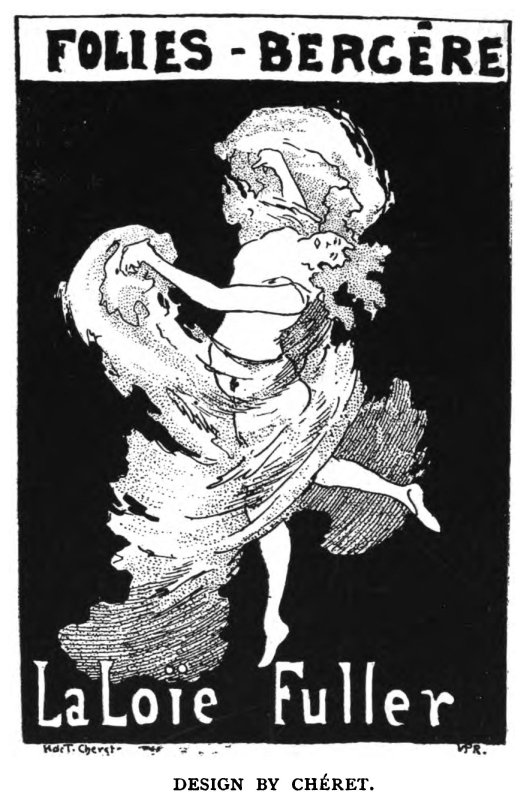
Original
Loie Fuller bills, in all of which the design is the same but the colouring different, is worth between thirty and forty shillings. These designs are among the most daring and characteristic specimens of Chéret's amazing colour, and as they only measure forty-nine by thirty-three inches, they are of manageable size, and should find their way into the portfolio of every collector. The set of unlettered decorative panels which were described in an earlier part of the book, is at present sold by all dealers for five pounds. It goes without saying that proofs before letters, or prints on special paper, of the posters of Chéret, or of nearly any other artist, are much more valuable than ordinary copies.
Most of, the posters of other living French artists may still be procured for a few shillings, but it is extremely improbable that such a state of things will long continue to be the case. Already examples by men of the modern school, such as Toulouse-Lautrec, Anquetin, Bonnard, Steinlen, and Ibels, are in great demand, and collectors should use the present opportunity to procure a series of these curiously interesting designs before the prices rise. Even now, Lautrec's first attempt, "Le Pendu," has become rarissime, and is valued at something over a sovereign. What has happened in this case will doubtless happen in the case of "La Reine de Joie,"
"Jane Avril," and Lautrec's other posters. The designs of Grasset are rapidly taking their place by the side of those of Chéret in the estimation of collectors, with the result that several of them command large prices. Thus the "Librairie Romantique," which was offered in 1891 for three francs, was priced by the same dealer in November, 1894, at twenty. What is going on in the case of Chéret, Grasset, and Lautrec, is going on, though it may be somewhat less rapidly, in the case of those other artists who have assisted to make the French affiche the charming and artistic thing it is.
The posters of those artists who were the pioneers of the artistic poster movement in England are extremely rare. They worked in the days before the English collector existed, and any copies of their designs not actually posted, probably fell into the hands of the waste-paper dealer. I have been unable to trace any copies of the advertisement done by Fred Walker for "The Woman in White," but the original design has been recently exhibited in London, and the price put upon it by its owners is seventy guineas. Copies of Mr. Walter Crane's "Hippodrome" bill are extremely rare, as are those designed by Professor Herkomer for the "Magazine of Art," "Black and White," and the exhibition of his own works. Turning to the younger men, it is interesting to note that Mr. Dudley Hardy's "Yellow Girl" sells in Paris for twenty francs, the large "Gaiety Girl" for half as much, and the smaller bills for the same play for five francs. The first poster which this artist did for "St. Paul's" is very difficult to meet with; it will doubtless be among the most valuable of Mr. Hardy's designs. Mr. Beardsley's "Avenue" poster is quoted neither by Mr. Bella nor M. Sagot, and it may therefore be concluded that it is almost impossible to obtain it. The other posters of this designer are steadily increasing in value, and are eagerly sought for by collectors on both sides of the Channel. Mr. Greiffenhagen's "Pall Mall" poster, which has met with much success abroad, is worth about half a sovereign. The dainty little bill which Mr. Wilson Steer did for the exhibition of his paintings at the Goupil Gallery fetches about the same amount, and is rapidly becoming scarce. It is pleasant to think that the early efforts of English artists are welcomed by French collectors as enthusiastically as the masterpieces of French artists by collectors in England.
The poster is obviously difficult to collect, because of its size. Not all of us are proprietors of such an immensity as the Chicago Exhibition. Most of us, on the other hand, could paper a room with posters of Lautrec alone. Everybody, however, can put the smaller bills into a portfolio, while the larger ones may be mounted as ordinary school maps. The collecting of pictorial posters needs nothing more than a little heroism.
In the foregoing chapters, I have attempted to outline the history of art as applied to the poster, and to give an account of the pictorial placard in the present state of its development. The number of names, eminent in the history of various modern arts and crafts, who have applied themselves to the production of the pictorial poster seems to me to justify the publication of this book. The fact that men so highly endowed as Chéret and Lautrec deliberately choose to appeal to the public chiefly by means of the affiche, well knowing that their gallery is the common hoarding, places the illustrated poster outside the bounds of ridicule. A modern art critic of high repute and of enormous energy has assured us that, in these days, to neglect the poster is mere folly on the part of those who care for the application of taste and skill to the objects of everyday life. We are apt to talk of artistic periods; periods when the most ordinary objects had an aesthetic character of their own. It seems to me to be full of promise for the future that the hoarding should be among the first necessities of modern civilization to be rendered charming by the skill and imagination of the artist. Art is generally supposed to be inimical to commerce, and commerce inimical to art, yet here we have the two combining to the advantage of both, and succeeding in making the beautiful an incident of the necessary.
